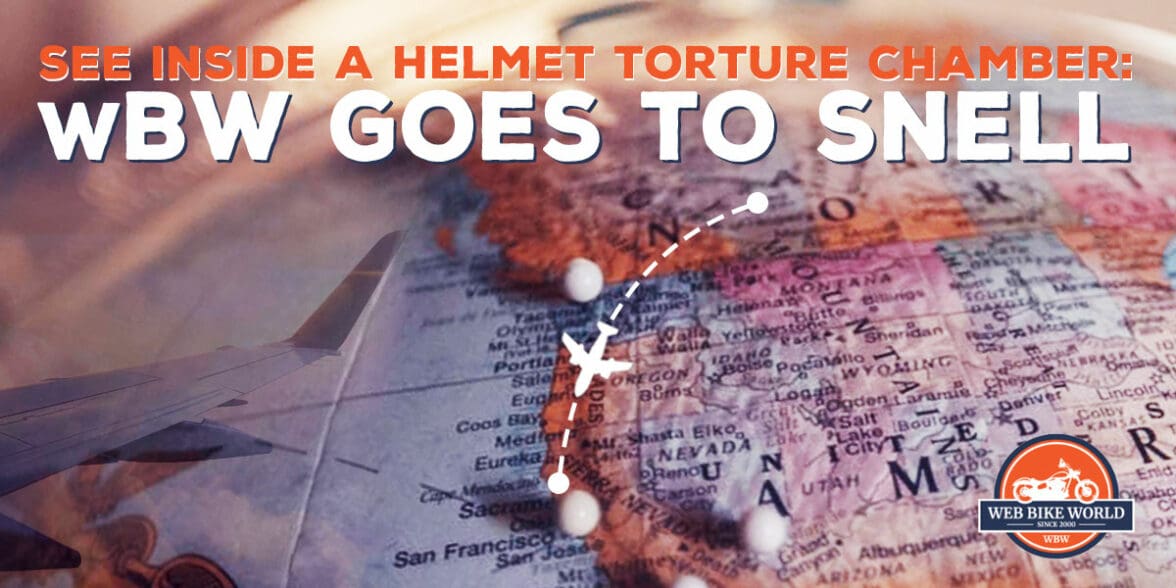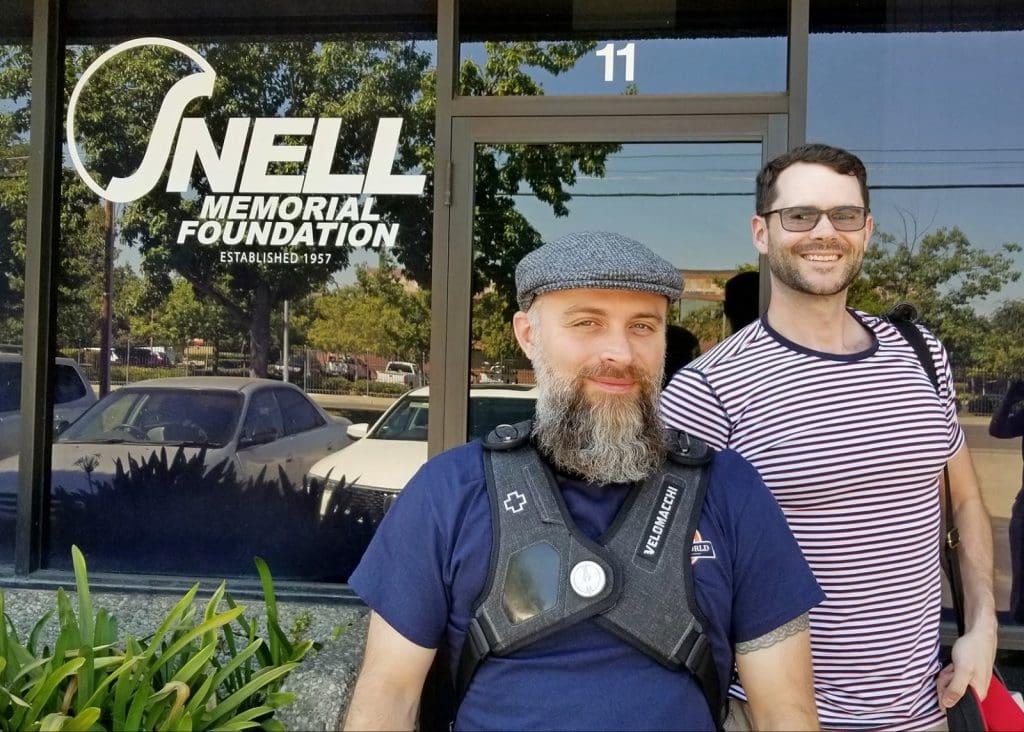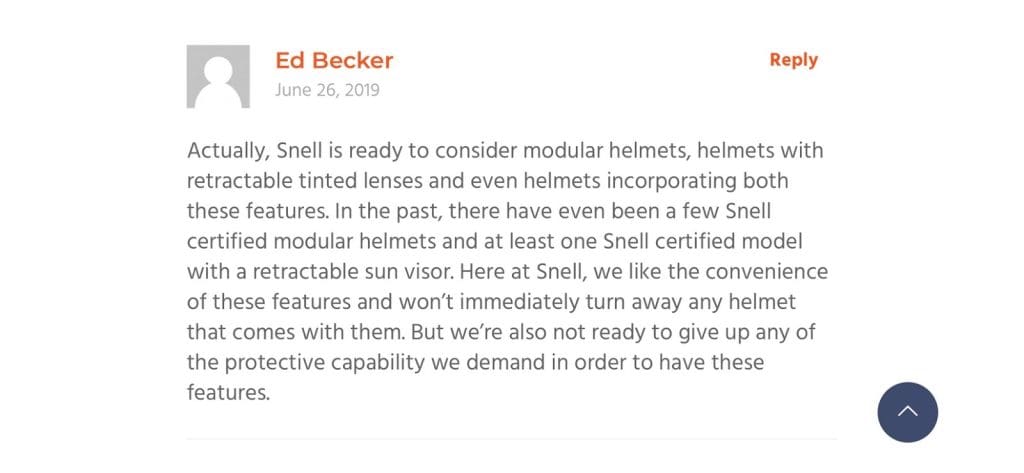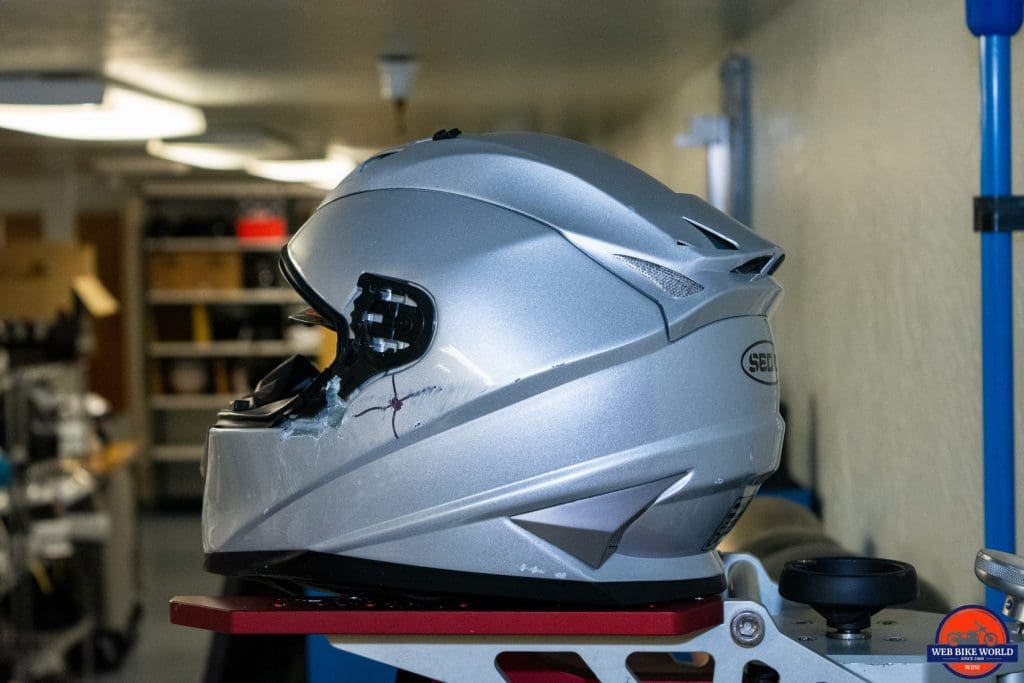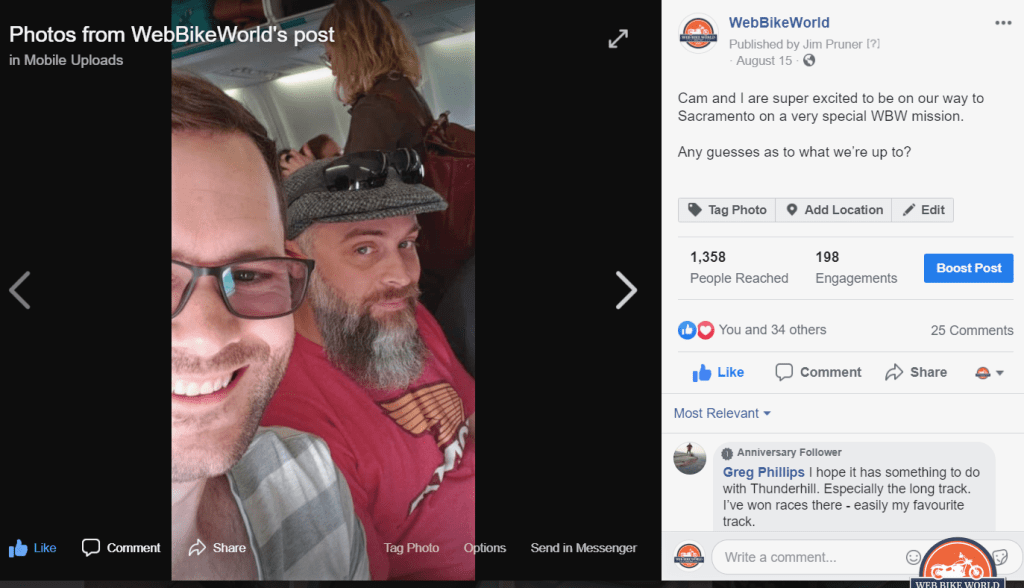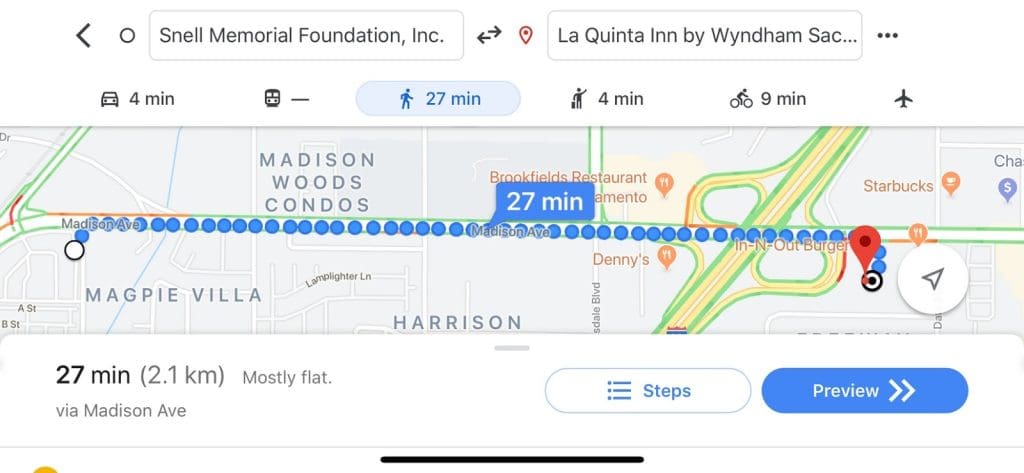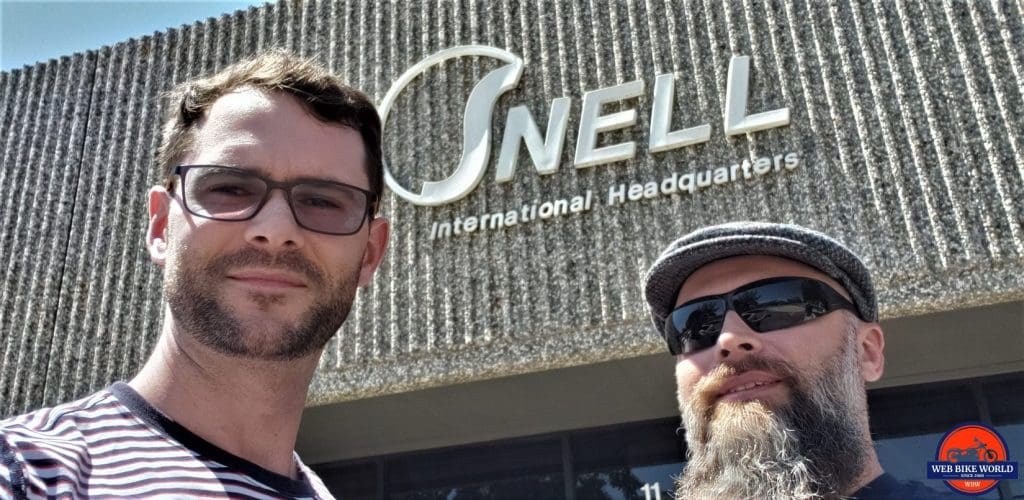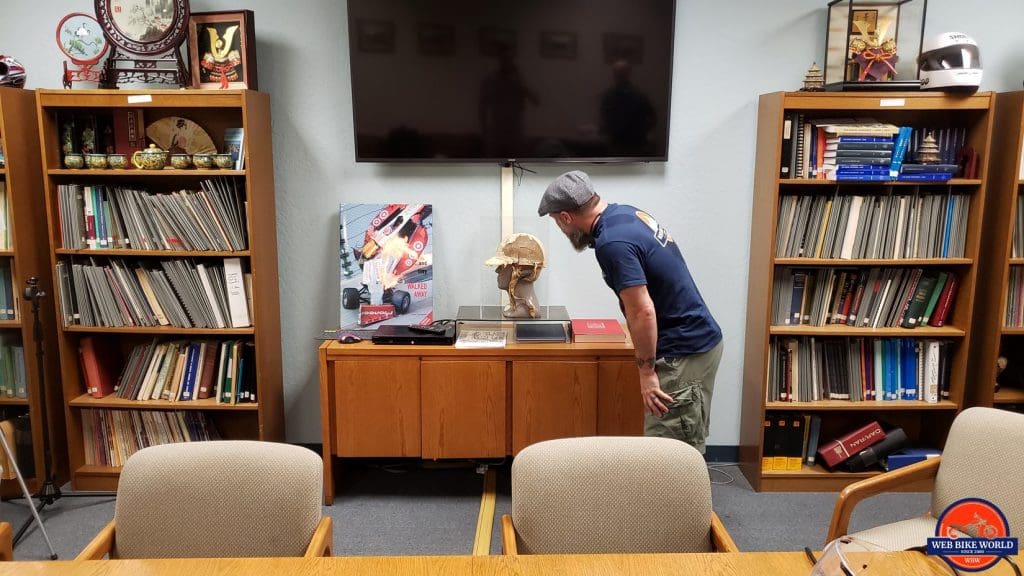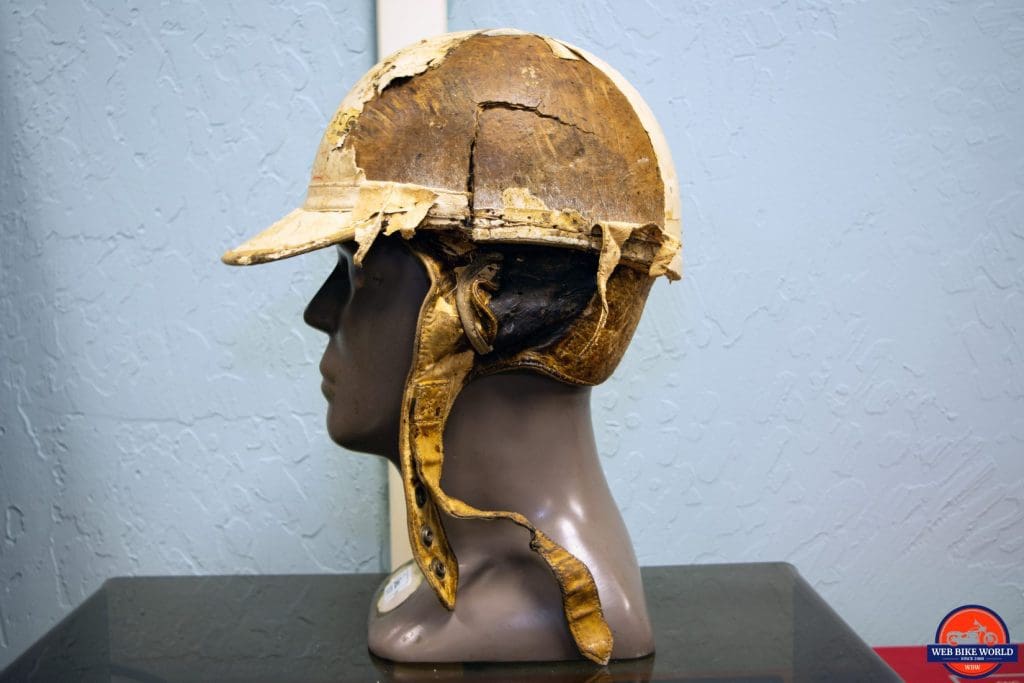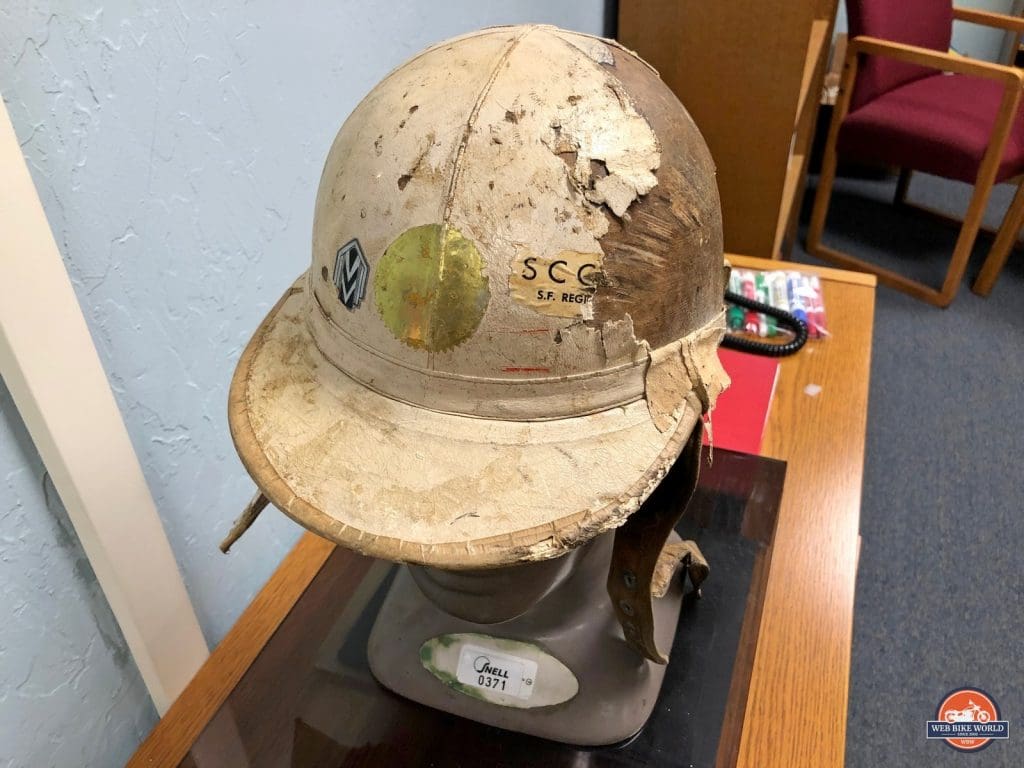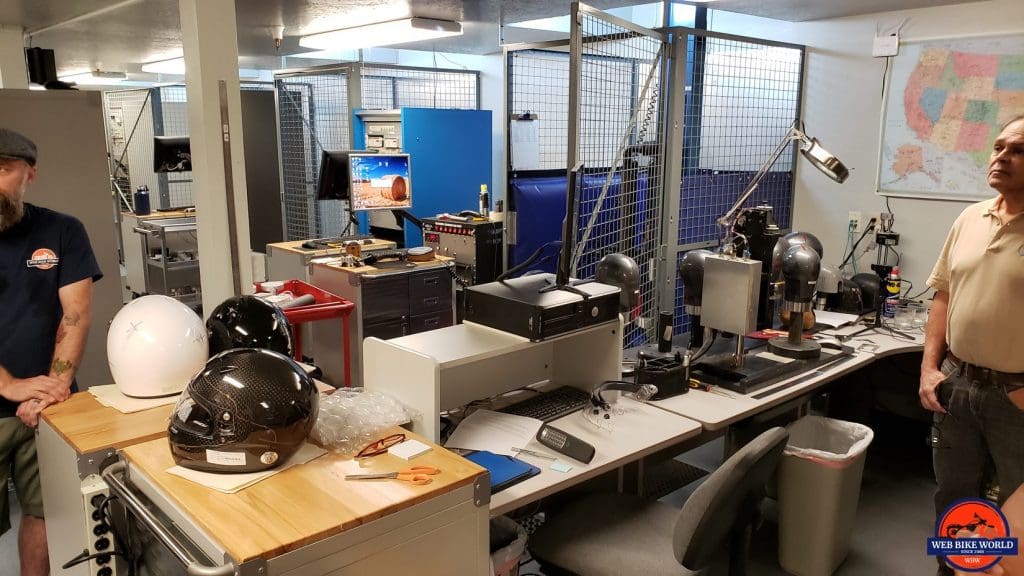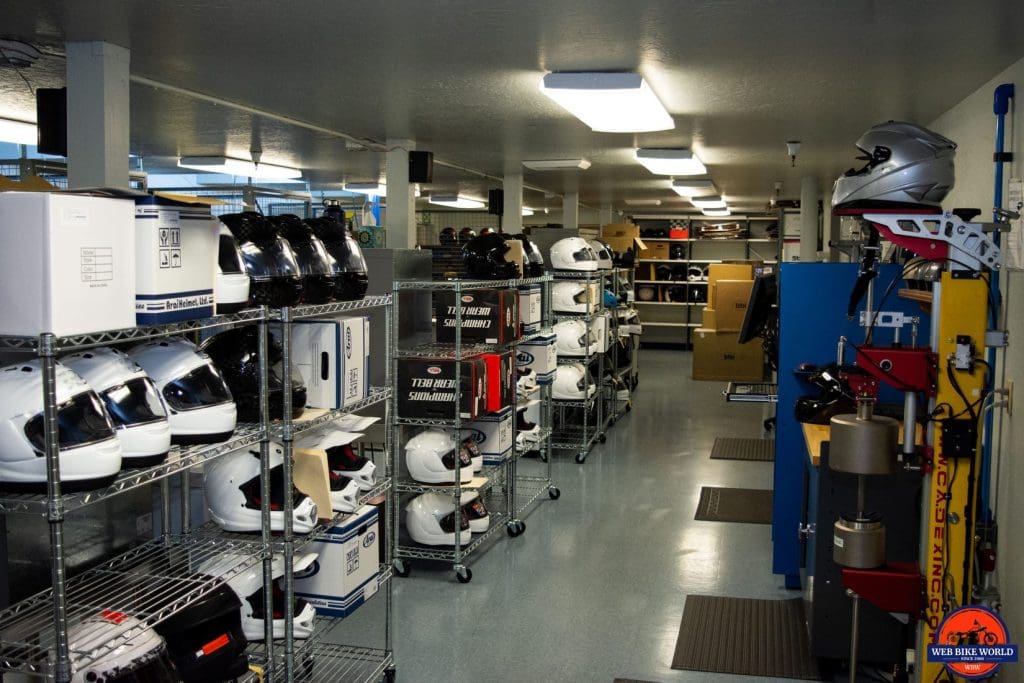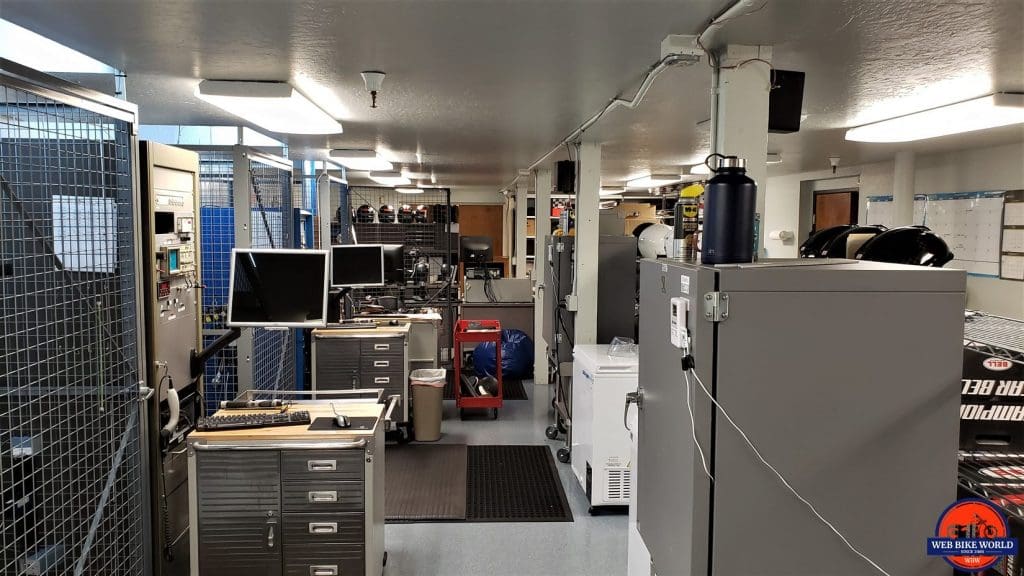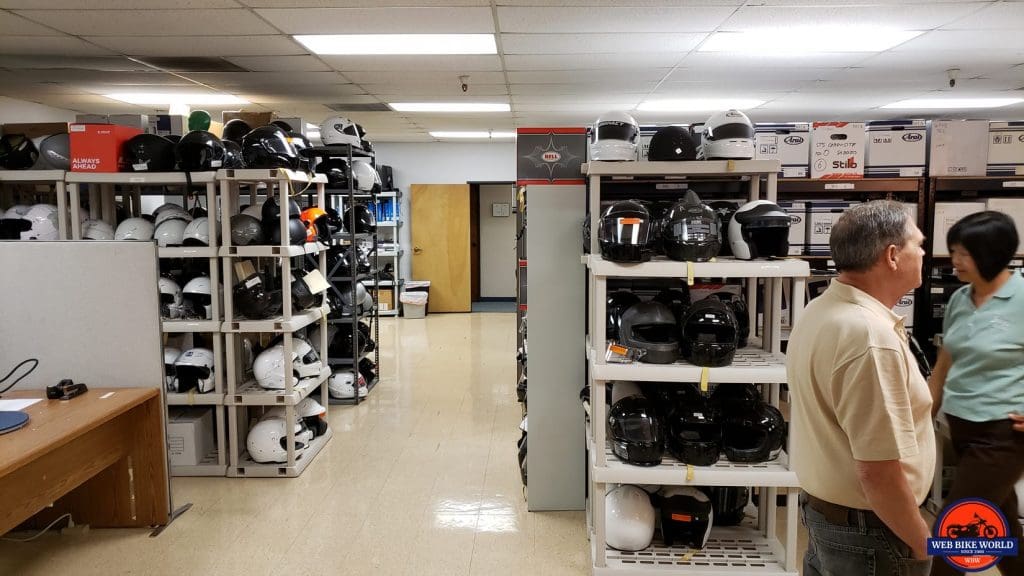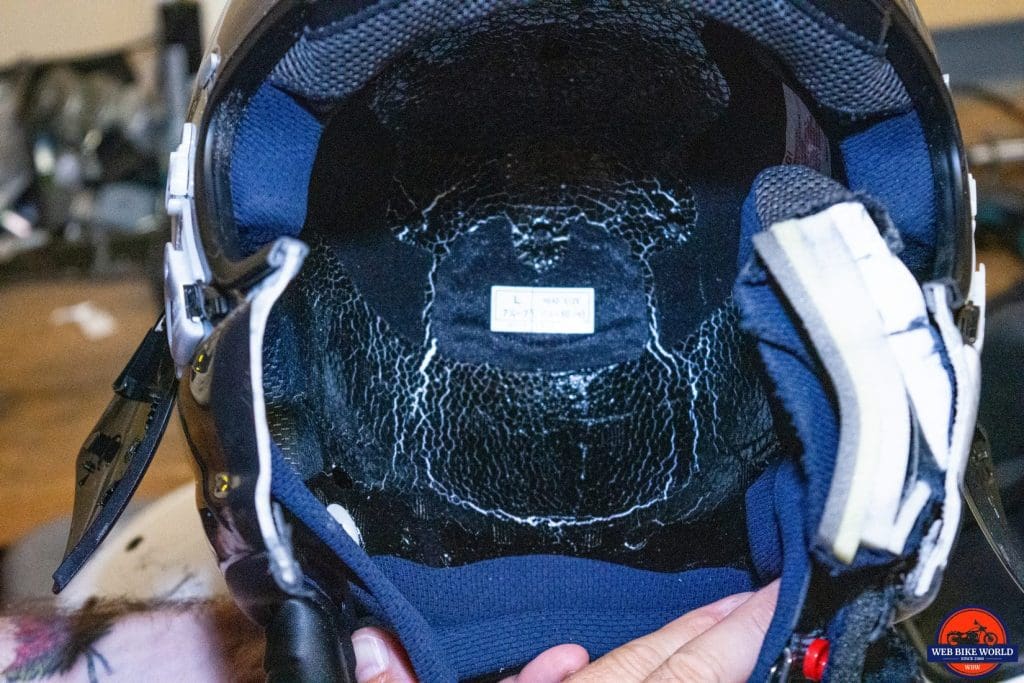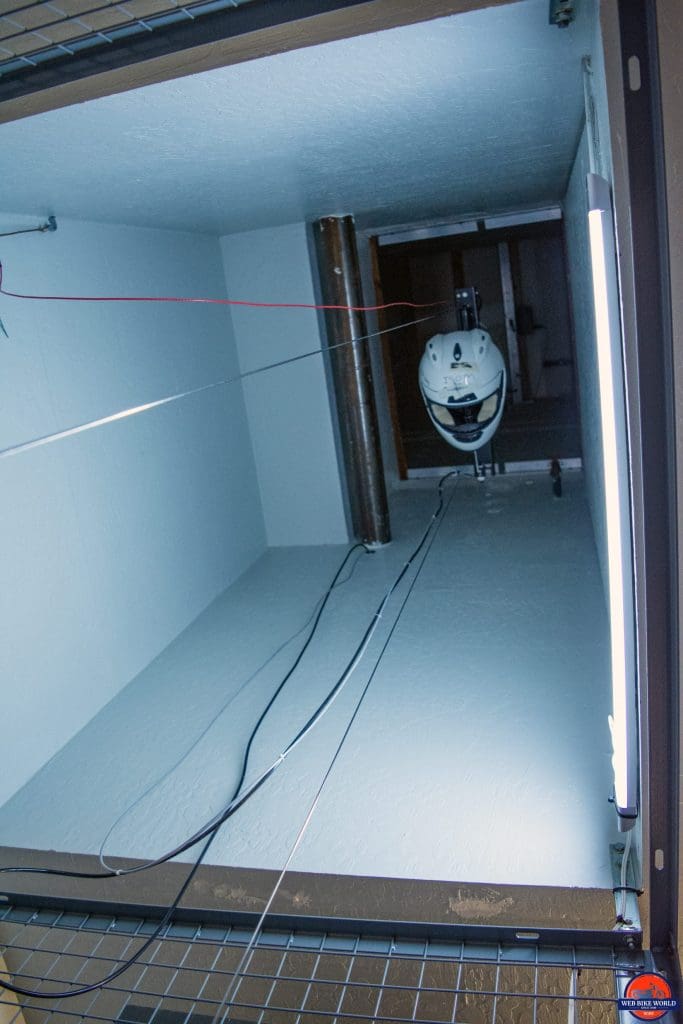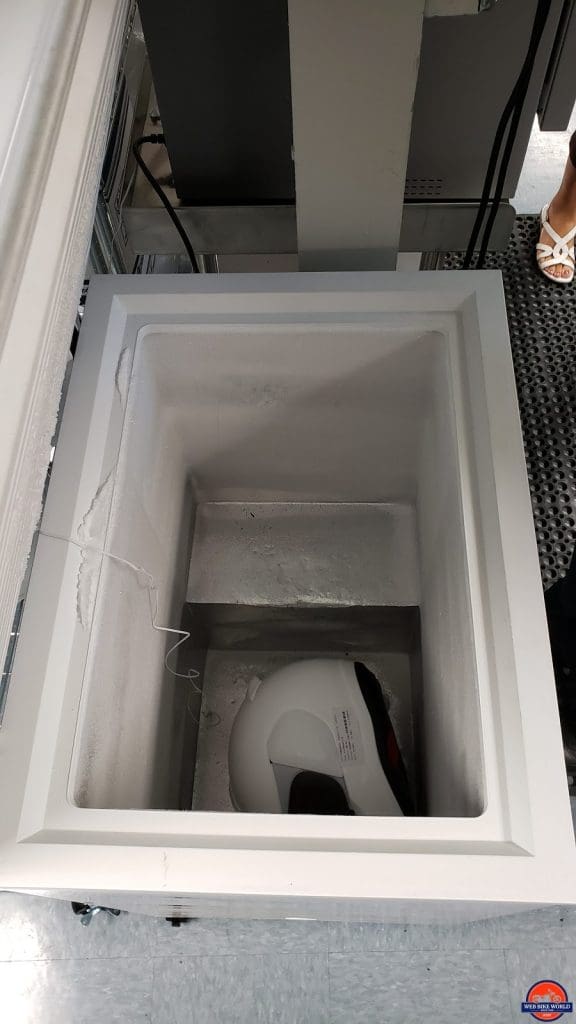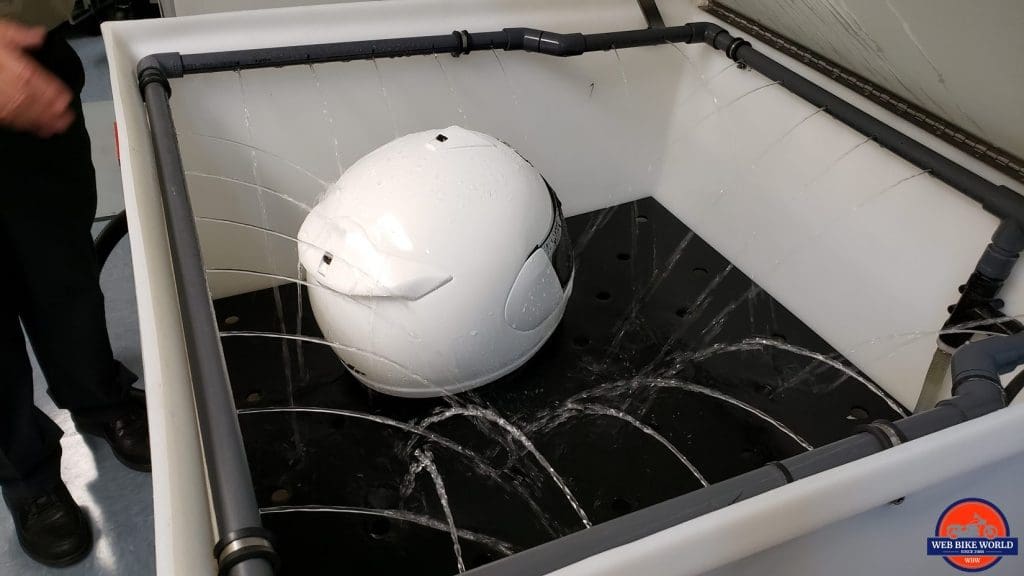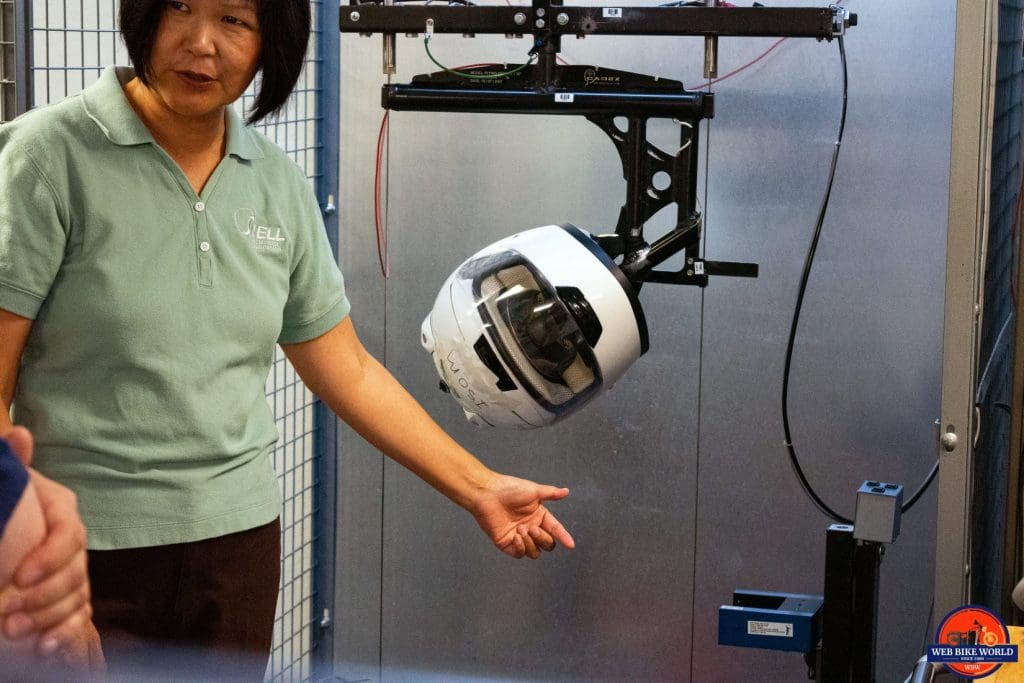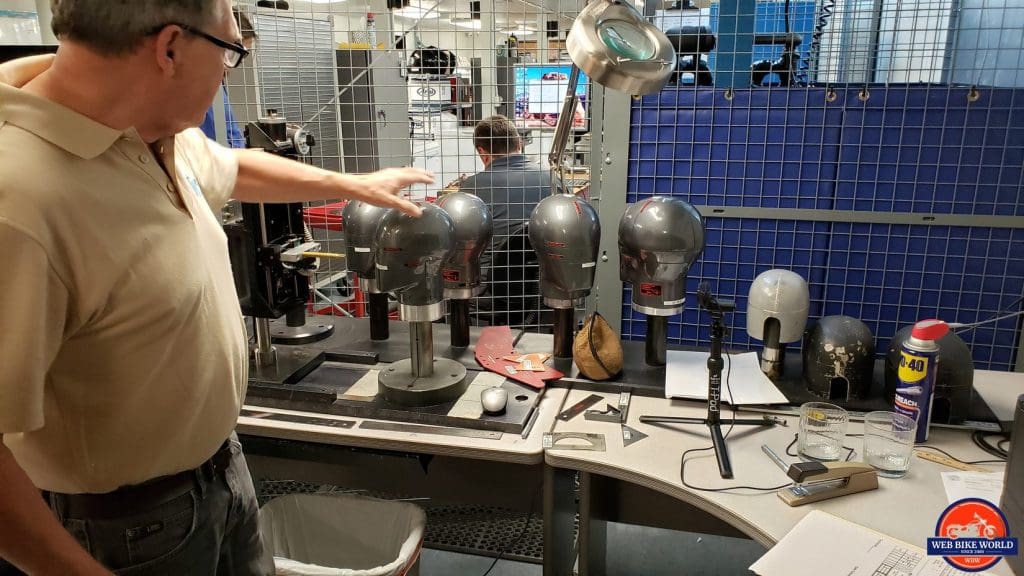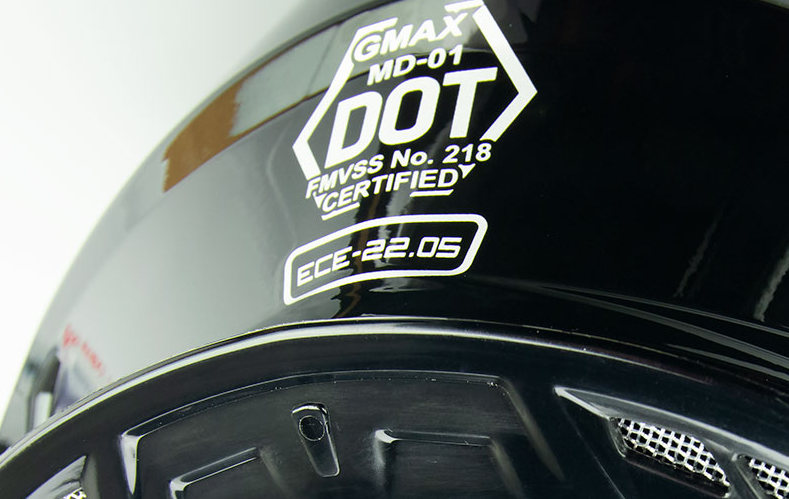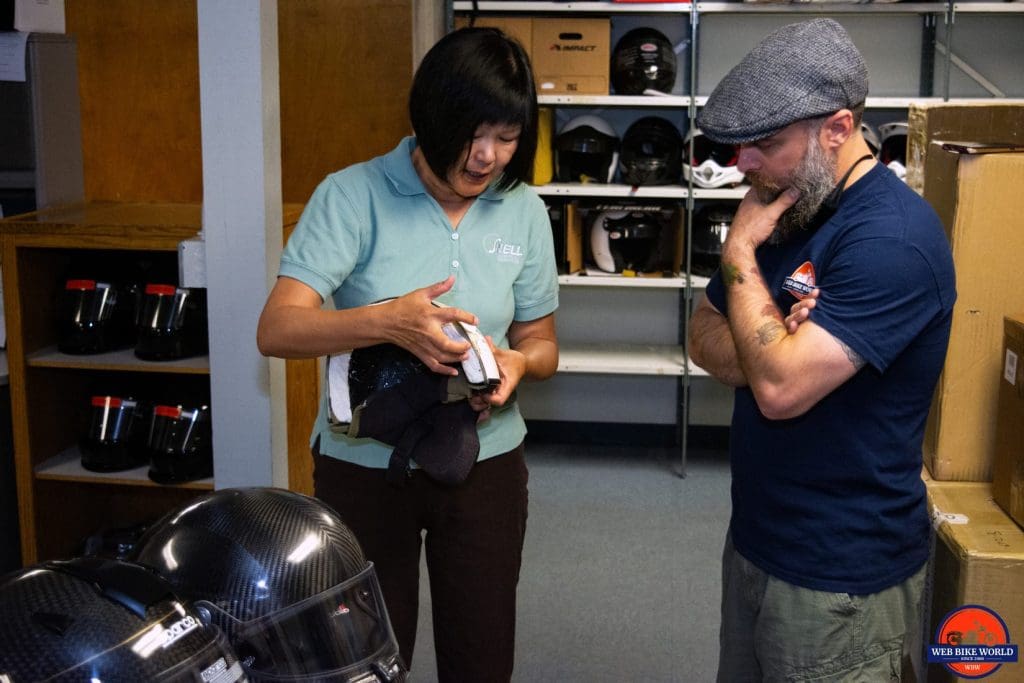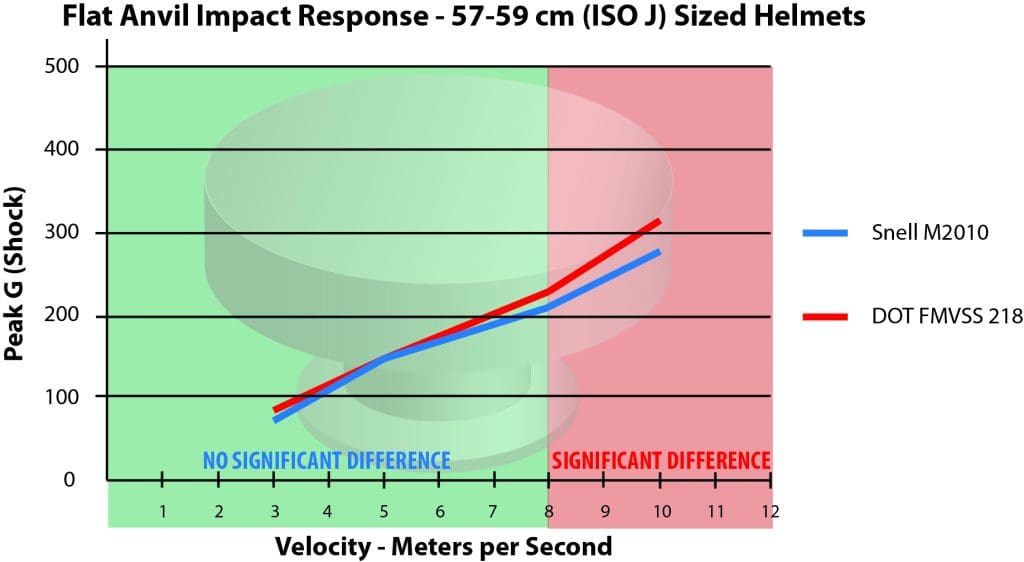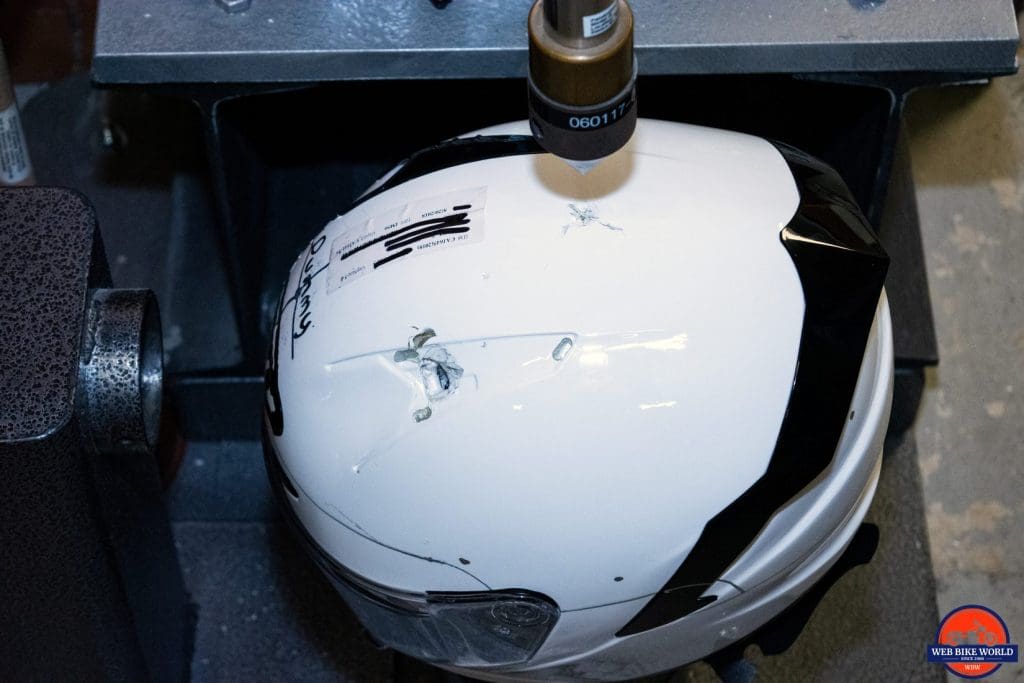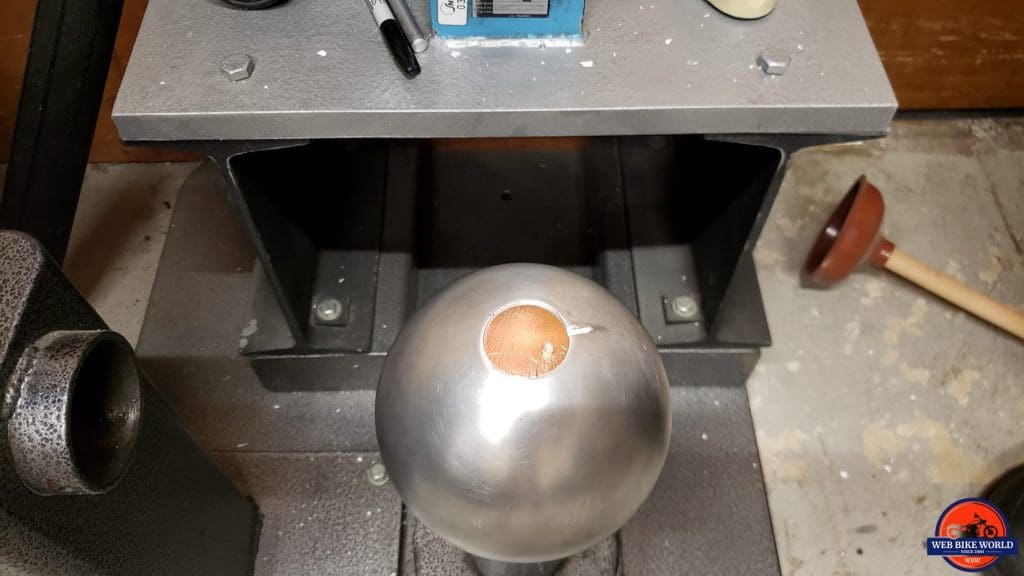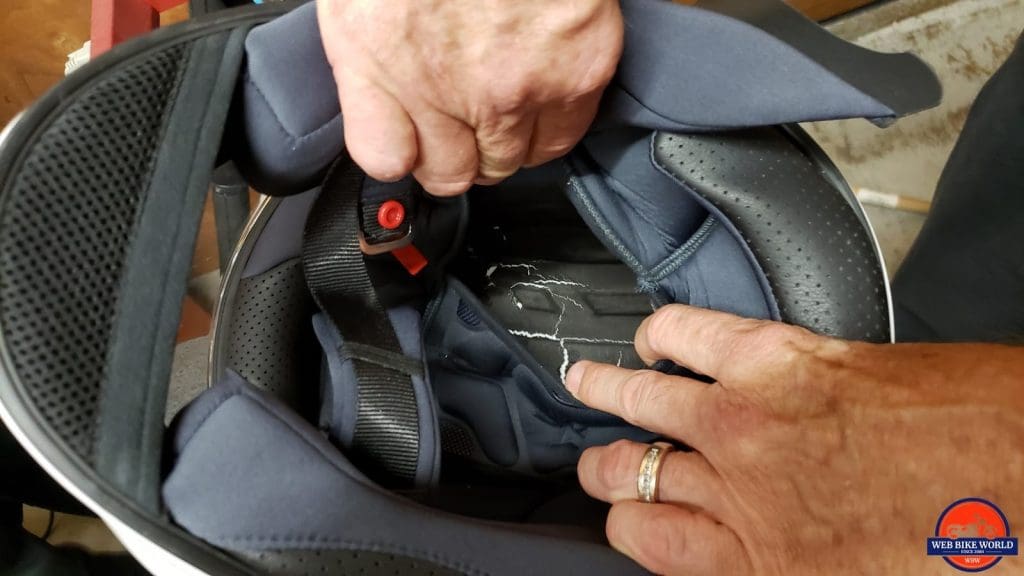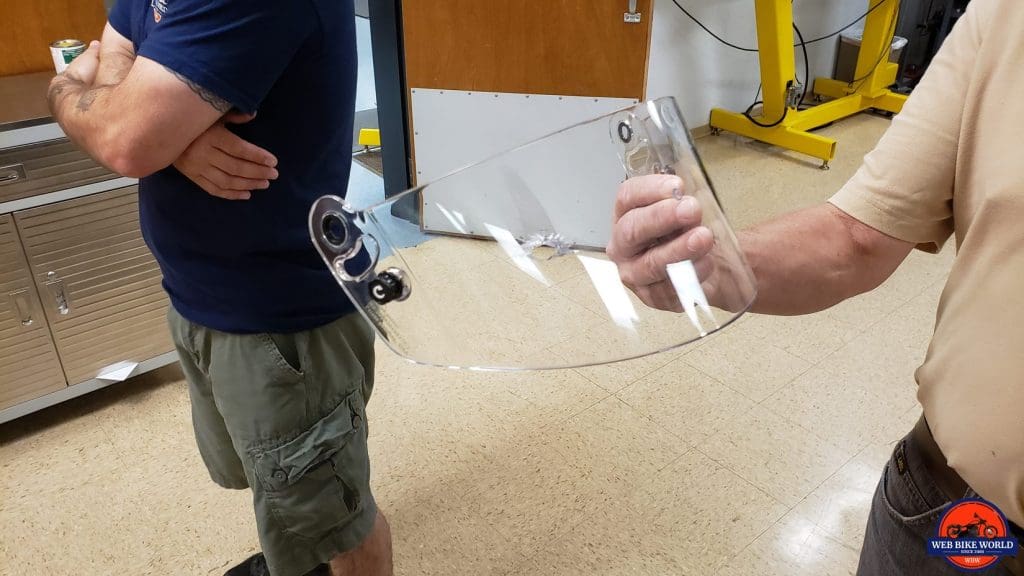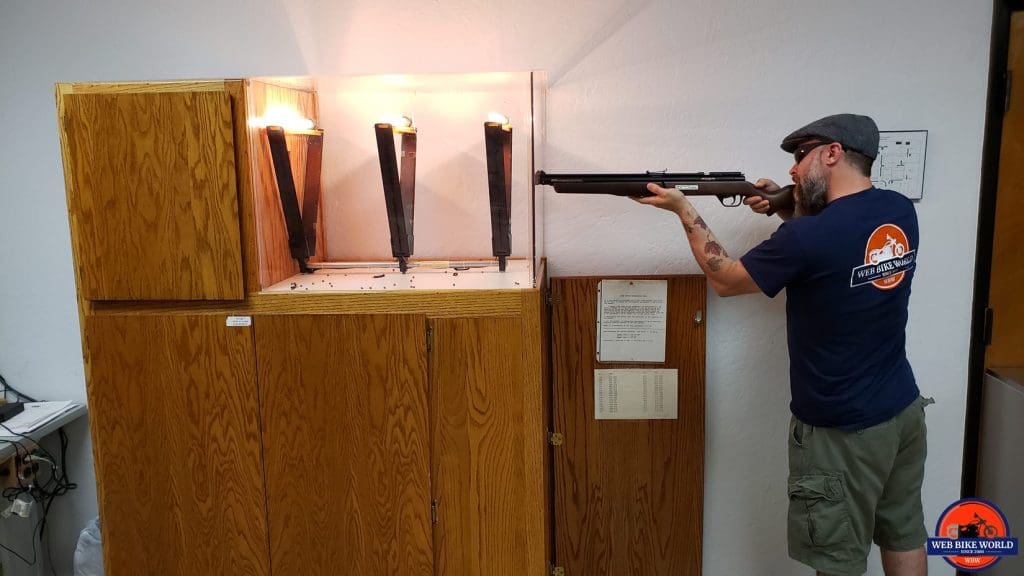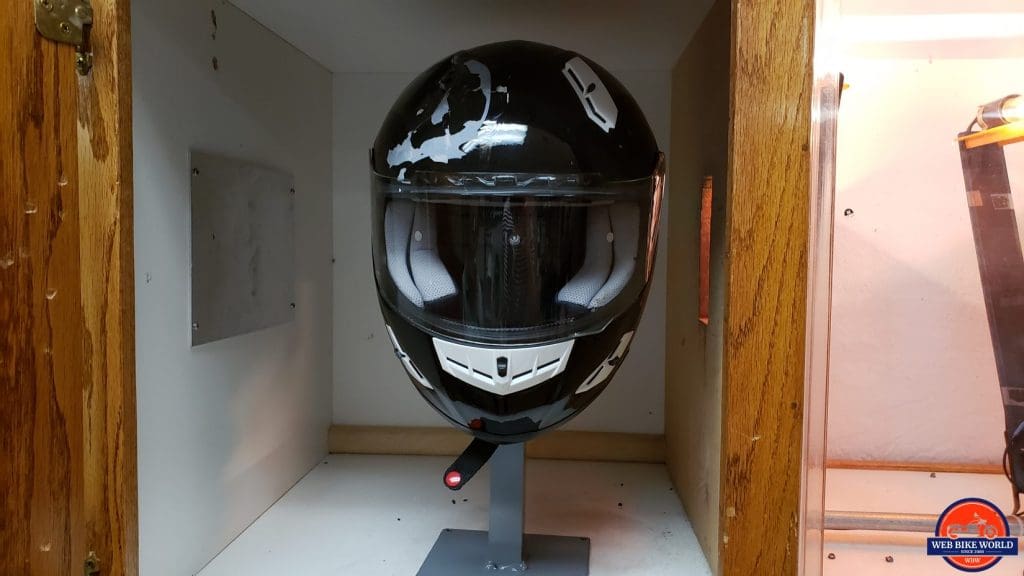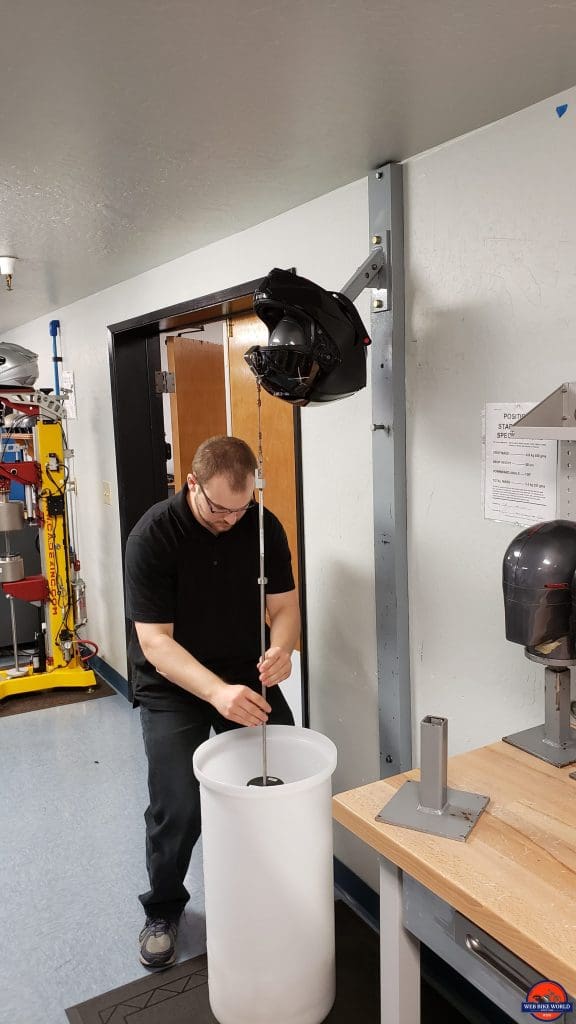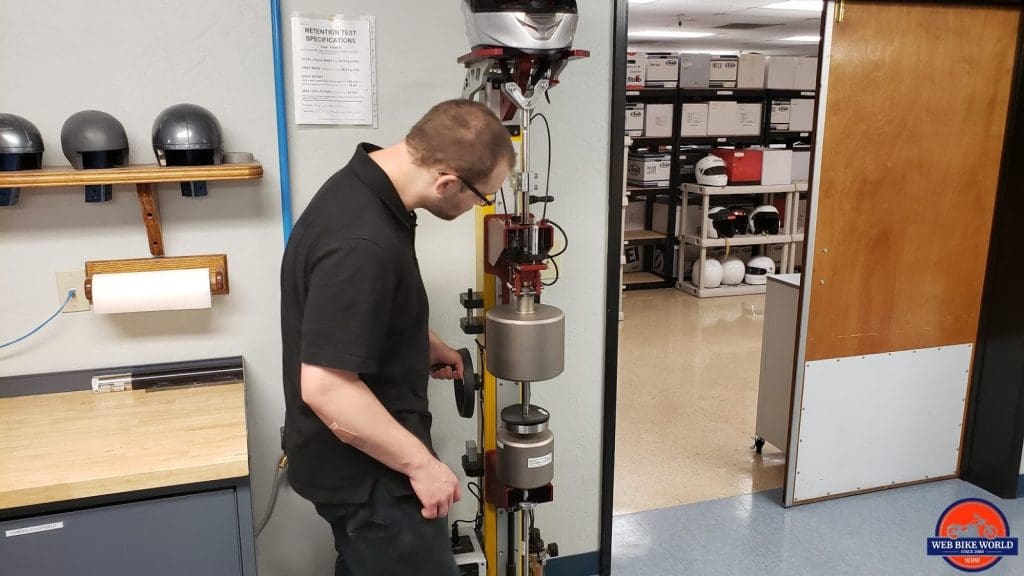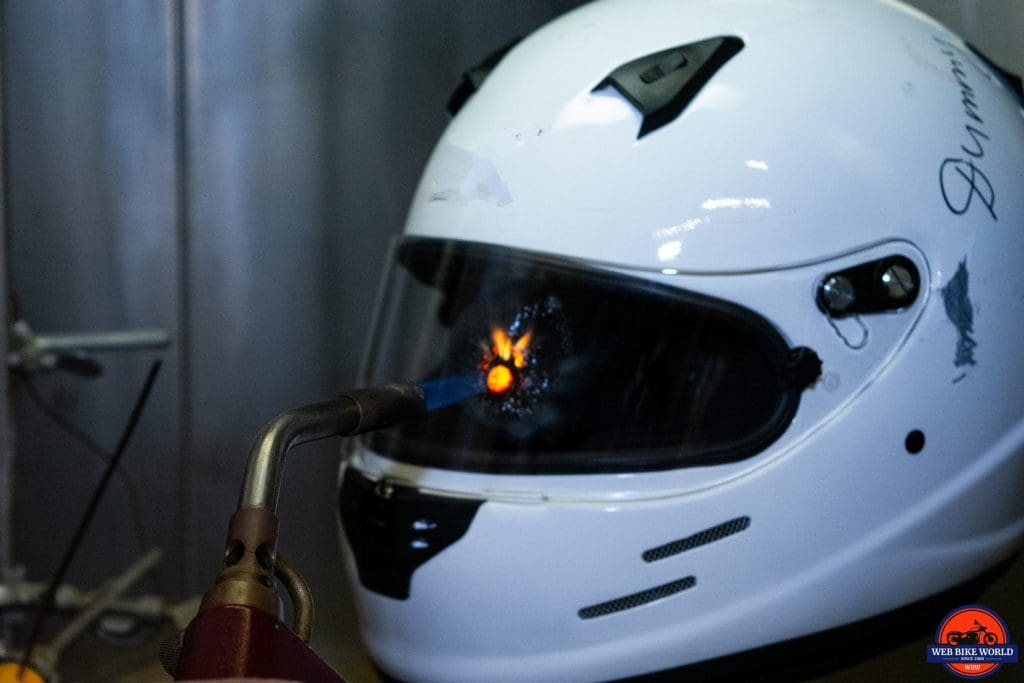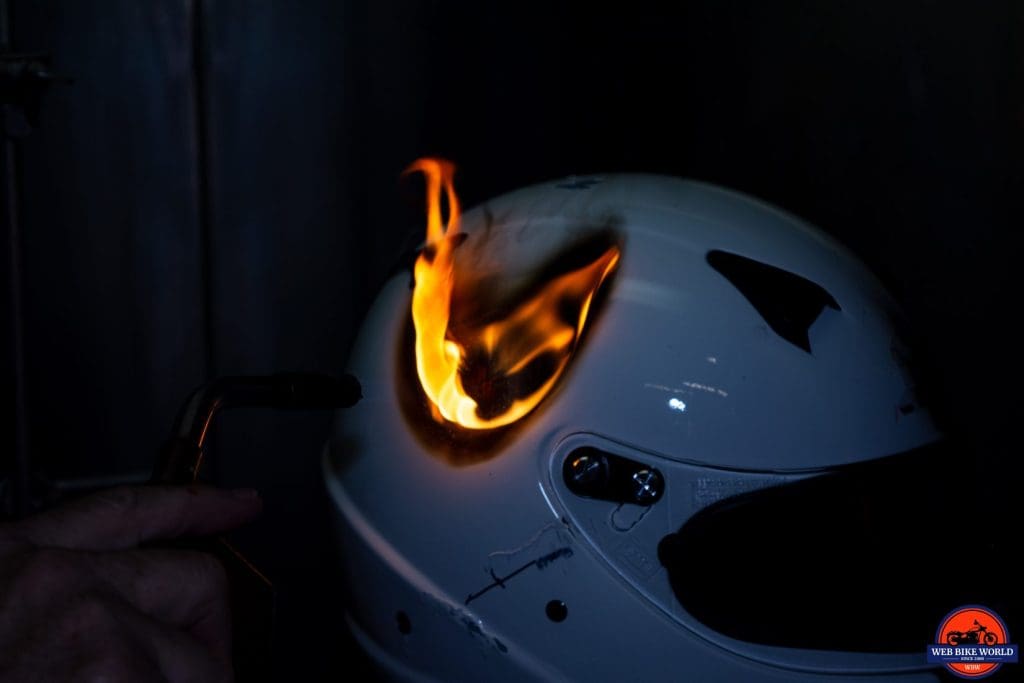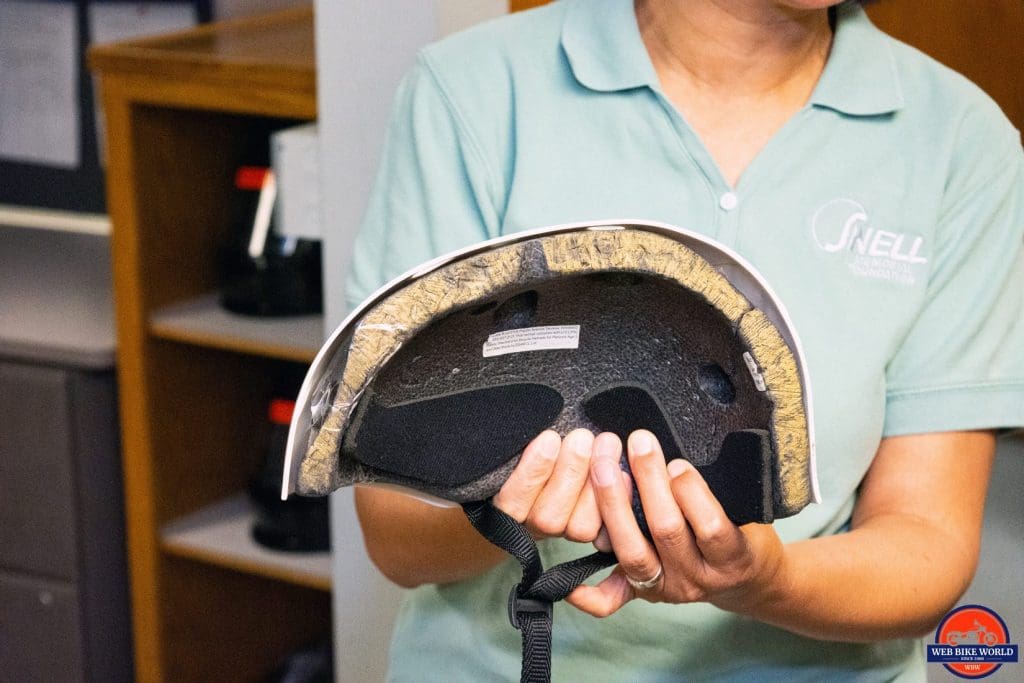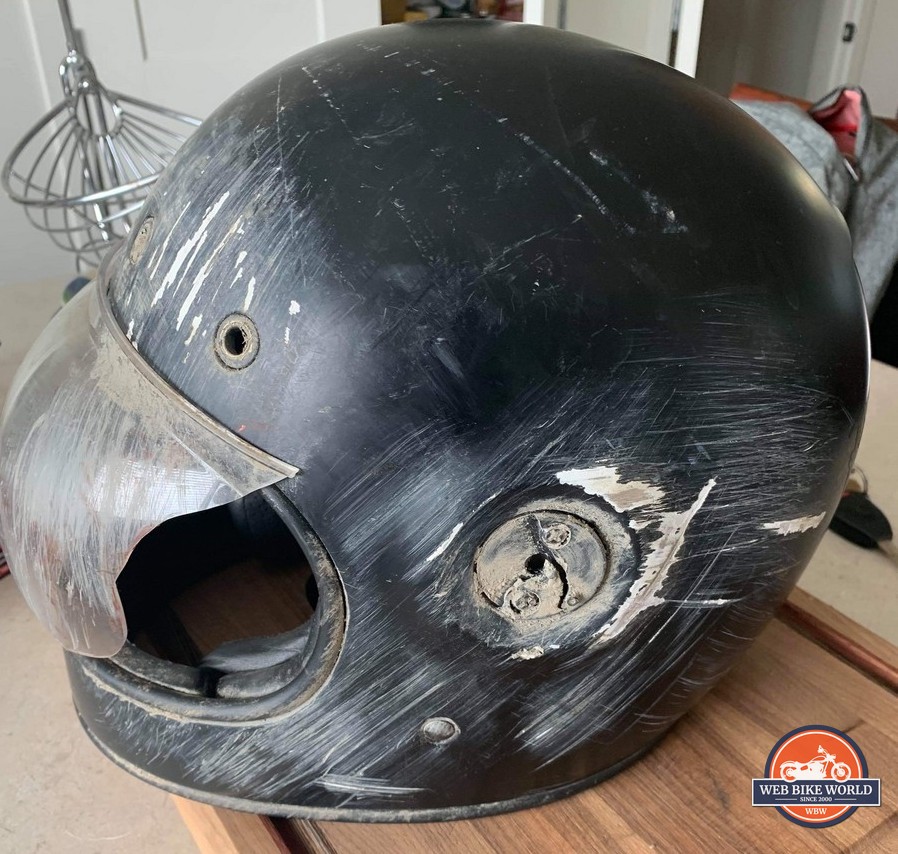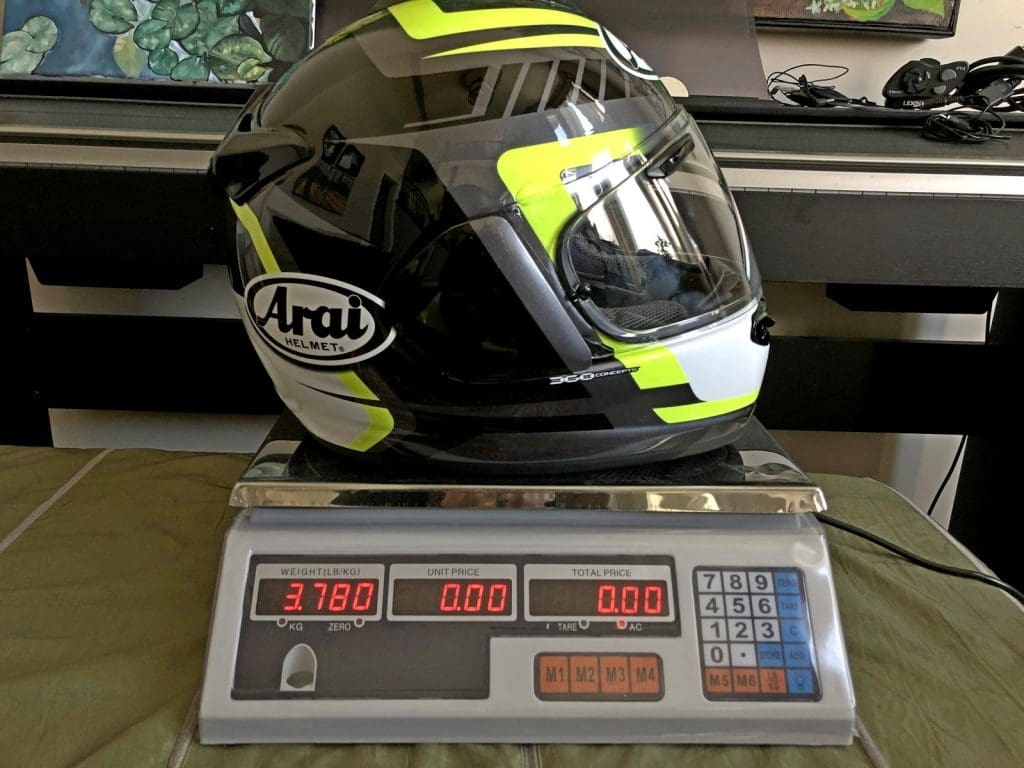I recently wrote a review of the Bell SRT Modular helmet that was, in my eyes, pretty standard wBW quality and unremarkable.
Originally it had been assigned to one of our other reviewers before being passed to me which again seems unimportant. Looking back now a couple of months later I’m on the verge of calling it fate, destiny or maybe just good fortune.
Perhaps that sounds a bit melodramatic, but the way I wrote that particular review coupled with our Content Editor Cam’s follow up efforts led to the two of us visiting the Snell Memorial Foundation in Sacramento, California.
If it sounds like I’m basking in the glory of doing such a great job on the review that it prompted the invitation, that’s not the case. The truth? It was my inability to get some important facts straight (ineptitude?) that can be given the credit.
That realization makes me chuckle, but hey… I’ve always been more often lucky than good so it’s nothing new!
The Squeaky Wheel Gets The Grease
I’ve been thinking a lot about why most modular helmets aren’t Snell rated for some time now. Click on that link to see Cam’s article he wrote based on the learning we received on the visit to Snell.
My consternation has been coming out in several of my helmet reviews and in any conversations I’ve had with helmet manufacturer representatives.
I had some theories about it in mind:
- Maybe it’s because integrated sun lens/visors necessitate having a void in the EPS foam layer creating a weak spot often exposed during the impact/penetration testing?
- Maybe the chin bars won’t stay shut during impact testing?
- Maybe Snell standards have risen to unreasonable levels?
- Maybe Snell just prefers Arai full face helmets?
I’m not sure why I didn’t just reach out to someone at Snell directly via email or phone to get some answers. I often fire off emails without a second thought to all kinds of people in the industry looking for input and clarification. Sometimes they even answer.
Snell is a bit different for me. I had them up on a pedestal of sorts whether they wanted to be there or not. I did visit their website, but couldn’t find anything specifically useful on this topic and I felt overwhelmed and intimidated by the dizzying pages of scientific journal type print there.
I foolishly thought they likely wouldn’t respond to any emailed questions because they had better things to do. This is the “world-renowned Snell Memorial Foundation” after all, right? THE authority on what makes a brain bucket safe. The stamp of approval mandatory over many years for all racing helmets! SNELL!
Who am I to pester the brain trust of this mighty institution of safety with my silly questions?
I Was So Wrong
It turns out I couldn’t have been more wrong about the 9 individuals who work at the SMF (Snell Memorial Foundation). This is a not-for-profit organization devoted to saving lives and it shows.
My impression of them now after the tour? They’re a small, close-knit group and very down to earth. The staff there are all willing to engage in lengthy, excruciatingly detailed conversations about their testing standards/methods and to share knowledge in general. They seem to enjoy their work, feel it’s valuable, and take it extremely seriously.
They don’t build helmets (or even want to). They politely excuse themselves from worrying about manufacturer or industry business interests ahead of their own agenda. Instead, they focus only on making sure helmets are built better so that people in crashes can avoid injury. At the same time, they come across as being confident in their methods/opinions and open-minded to critique and different views for the most part.
I can’t begin to express how much that impresses me.
I may have tossed out some unwarranted assumptions based on my Snell certification confusion in the review of the Bell SRT Modular. That got the attention of Stephen Johnson, their Administrative Director and Lab Manager. After reading it, he wanted someone from Snell to reach out and alleviate my confusion, so he sent in Snell’s “big gun” so to speak to set me straight.
I’m grateful he did.
“Dude… That’s Ed Becker Commenting!”
That excited Facebook message randomly popped up on my computer screen about a month ago from Cameron Martel (our Managing Editor and my friend).
“Who’s Ed Becker?” was my response.
Ed Becker is the Chief Engineer and Executive Director at SMF. It was he that left several detail-rich comments at the bottom of the Bell review to explain their stance on modulars and integrated sun visors. If that doesn’t show how approachable they are I don’t know what does.
The correct answers to my questions are that Snell has nothing against certifying modular helmets or helmets with integrated sun visors so long as they can pass the standard barrage of full-face Snell helmet tests. Their view is that if a helmet has a chin bar on it the wearer should be able to expect it to function as more than just protection from sunburn.
Ed told me that more than a few modular helmets have been tested by them over the years and indeed the chin bar opening up during crash testing was an issue for some. Their standard is for it to stay closed even after being struck three times during testing.
Another Misunderstanding Of Mine About Snell Certification
Which helmets will become Snell certified and which won’t? Can any helmet pass on a good day?
That’s something else I admittedly didn’t understand before talking to Ed and Hong Zhang who is the Director of Education at Snell. There’s almost no chance a helmet will pass Snell testing unless the manufacturer designs it stronger than average and with specific characteristics right from the factory.
SMF doesn’t randomly test helmets that are put into production without the manufacturer requesting it for that exact reason: most of them would fail because they simply don’t protect well enough at higher impact speeds on flat or hemispherical surfaces. They also tend to fail penetration tests if endowed with certain other features that create a thinner layer of EPS foam.
We Need To Meet In Person
All this information was so satisfying to finally receive that I craved a trip to the laboratory to see testing in person. Cam felt the same way and asked Ed if that was possible. They arranged to meet with us both for a facility tour and chin wag session to learn even more. I was super pumped to go and could barely sleep the night beforehand.
Can wBW Test Some Helmets?
I wanted to bring a couple of helmets that aren’t Snell certified with us to test and see them fail or pass but it wasn’t possible, unfortunately.
The Snell staffers were open to the idea but said we needed to get the manufacturer’s approval beforehand. They do have confidentiality agreements in place and don’t want manufacturers to feel attacked or embarrassed if we published the findings here in wBW just to satisfy my curiosity.
How Much?
You may be wondering how expensive it is for a manufacturer to have a helmet tested? There seems to be a cost range between $1500 and $2500 from what I was told and Snell charges $1.25 per sticker to place on the inside of every helmet a manufacturer builds to sell afterwards. Each sticker has a unique serial number specific to the helmet it gets placed inside.
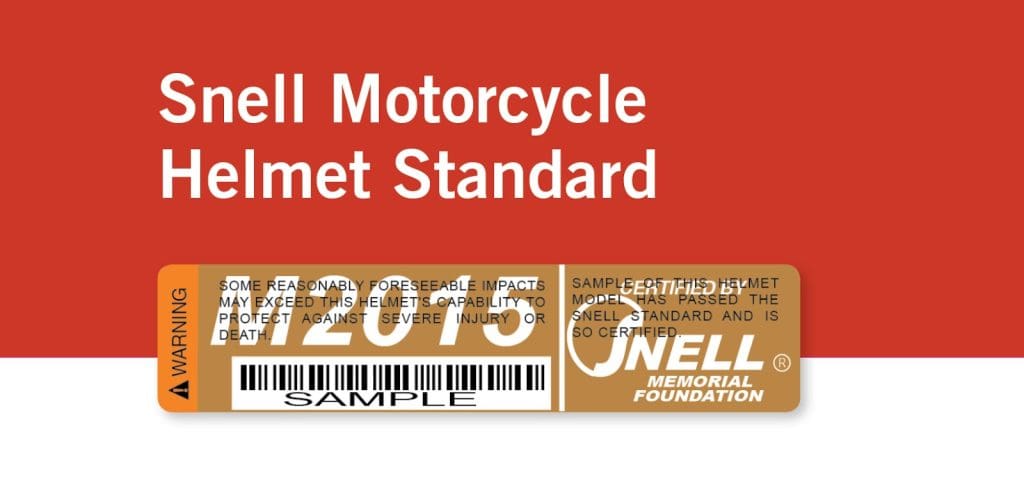
This is how they bring in funds to keep the lights on in the lab and it doesn’t seem like an unreasonable cost in my eyes. Not just motorcycle helmets are tested there. Automobile racing helmets, karting, bicycle, equestrian, harness racing, and other helmets are fair game as well.
Manufacturers also provide additional sample helmets going forward for random spot testing. Snell purchases those helmets directly from the market to verify no changes have been made post-certification.
I approve of that line of thinking.
That’s A No
Cam and I did reach out to a few manufacturers looking for permission but couldn’t get approval to play mad scientist in the Snell lab. As I mentioned before, most manufacturers already know which helmets will and won’t pass this level of testing because they have their own labs to work out of just like SMF.
So there’s another key learning point for me and my clever notion of there being a “Cinderella” helmet out there that might miraculously pass the Snell standard if given a chance. If it doesn’t have a Snell sticker on it right from the manufacturer, regardless of how tough a helmet may seem to you or me – “it ain’t gonna happen”.
Ed promised to have plenty of “dummy” (previously tested) helmets on hand for us to pulverize regardless so we would get to see the whole process on the tour. Their lab tests about 2000 helmets per year so they definitely have a few extra lying around the place at any given time.
Sacramento
If you are a member of our wBW Facebook group you would have seen a photo of Cam and me at the airport teasing about a trip to Sacramento on top-secret wBW business. Both of us were giddy and annoyed everyone around us with excited motorcycle-related chatter the entire 2-hour flight. I sincerely apologize if anyone reading this was on board, but we couldn’t help ourselves.
We stayed at La Quinta Inn on Madison Avenue that night. It was chosen for its close proximity to the Snell Memorial Foundation lab. I wouldn’t recommend the room we stayed in unless your idea of luxury is the strong smell of mildew we endured during our approximate 8-hour stay. At least the AC worked well to keep the spores from completely overwhelming us as we slept.
Crazy Canucks In California
I’m a fairly active person who eschews waste, loves exploring new places, and meeting the people there. When I noted we were only a 27-minute walk away from SMF HQ, I knew I had to convince Cam to walk in lieu of getting a cab or Uber. So off we trekked along Madison avenue in 40 degrees Celsius (104 F) temperatures with bright California sunshine on our faces.
We passed a few “interesting” local people behaving strangely along the way and what appeared to be a goat farm in the middle of the city before finally arriving at Snell drenched in sweat.
Despite our slightly haggard appearance Ed and Hong met us at the door then welcomed us inside. Our first stop was the conference room.
The Origin Of Snell
The furniture and decor inside is notably functional and even a bit outdated in the administrative section of the SMF. I appreciate the fact they don’t spend their resources on what I would deem unimportant “fluff” that comes second to the Foundation’s number one priority.
Inside the conference room, my eyes are drawn to a very old leather helmet resting on a headform covered by a clear plexiglass case.
Hong notices me looking at it and mentions it’s the actual helmet worn by William “Pete” Snell when he died while racing in a 1956 Sports Car Club of America event.
His death prompted the establishment of the Foundation by his friends and family to help ensure other racers and their loved ones avoid the same kind of preventable loss of life through standardization of better quality protective equipment.
There’s heavy damage on the left side of the helmet as you can see in these photos.
A two-sided indentation mark inside a heavily scrubbed area runs along the temple of the leather helmet and there’s a dark stain below it on the earflap. Hong speculates the stain is Pete’s blood.
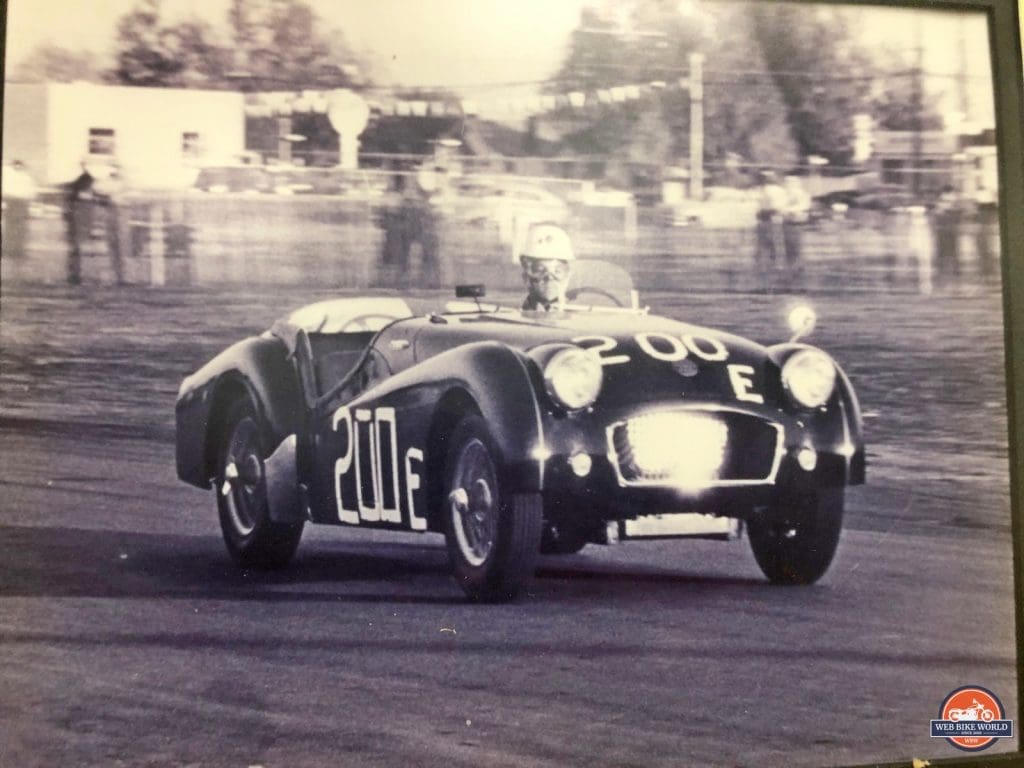
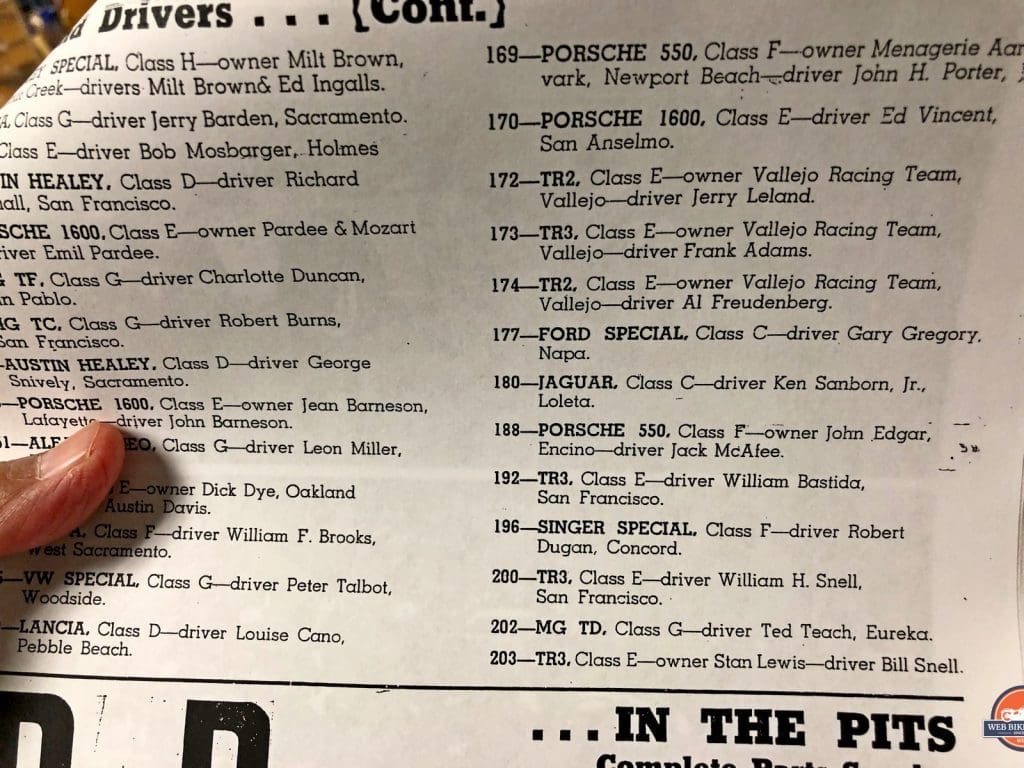
That helmet was the best available in 1956 but leather and compressed cardboard don’t compare to today’s technology. Neither Ed or Hong are relatives of Pete Snell, but I can tell they choose to have a connection to his death and feel proud to carry the torch forward in SMF’s cause of preventing further injuries and deaths.
I immediately feel a bit of a connection to Ed, Hong and everyone at the SMF.
They’re “reviewers” of products in a way, similar to us at wBW in some respects. Independent, brutally honest about results found with the ultimate goal being to help people. They’re kindred spirits if you will. We’ve only just met and I like them already!
The Laboratory
As we enter the testing area after finishing up in the conference room I am impressed with what greets me.
Shelves filled with many random helmets line the walls with high tech instrumentation, scopes and computers that are arranged logically and with efficient use of real estate in mind. Ovens, freezers, and water basins along with caged off impact testing apparatus are all there too.
We have arrived!
The Testing Process
Snell is known as “the gold standard” of testing because they demand the most out of helmets… period. Each January they shut down testing for 2 weeks they spend entirely on calibrating and fine-tuning their testing equipment to maintain testing accuracy. This place is high tech!
Impact & Penetration Testing
They want the least amount of energy measured in G-Force to transfer through the helmet to the wearer’s head REGARDLESS of where on the helmet above the “testing line” that force is applied.
You can see the shaded testing area mapped out on the diagram below.
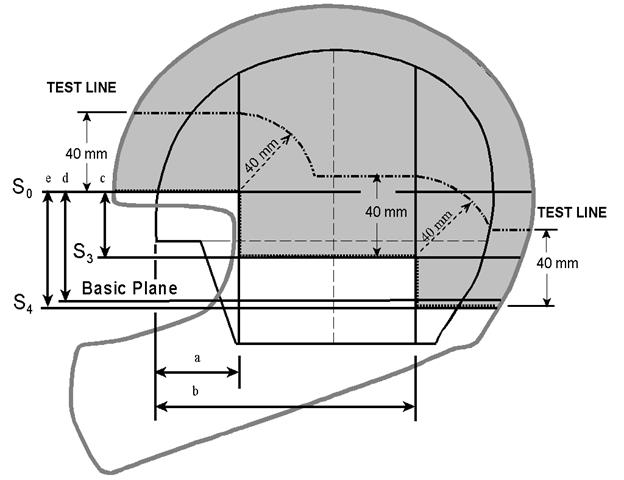
It might be a bit confusing to look at, but Ed and company explained to me that basically it’s an imaginary line running around the outside circumference of the helmet from one of your eyes to the other.
So anything above or slightly below your eye line is in play for the Snell helmet torture chamber. The testers there sadistically will target their strikes, pokes, and attacks at spots they figure will produce a failure.
Yikes! No wonder the manufacturers we contacted didn’t rush to give their blessing to us to bring their non-Snell helmets to the lab, eh?
Snell wants to measure less than 275 Gs when the helmet is dropped from 15 feet onto either a flat, rounded (hemispherical shaped) or square-edged steel anvil. They also do a second drop onto the same spot but from a lower height of 8 feet after the first one.
That is really brutal testing to yield such a low amount of force, my friends. Some critics claim it’s unreasonable to do a second drop in the same spot because the chances of that happening in the real world are slim. To them I would respond quite simply, it’s better to plan for the worst case scenario as much as possible.
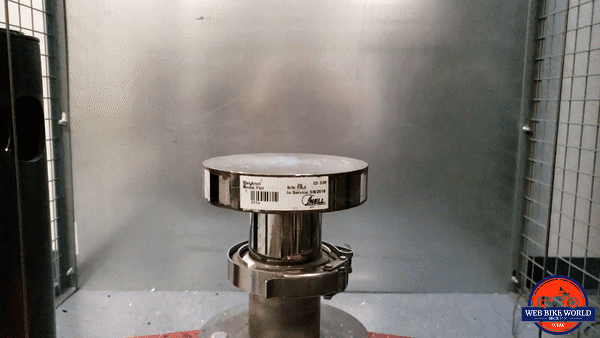
And on to the dreaded drop test…
[KGVID]https://www.webbikeworld.com/wp-content/uploads/2019/09/snell-memorial-foundation-video-07_Trim.mp4[/KGVID]Hot, Cold Or Wet
Did I mention Snell changes the temperature of the helmets before testing them and sprays water at them for 4 hours as well?
From the Snell website:
Cold
“The sample shall be conditioned by being exposed to a temperature of -20 ±2º C (-4 F) for a period of not less than four (4) hours, or more than twenty-four (24) hours.
Heat. The sample shall be conditioned by being exposed to a temperature of 50 ±2º C (122 F) for a period of not less than four (4) hours, or more than twenty-four (24) hours.
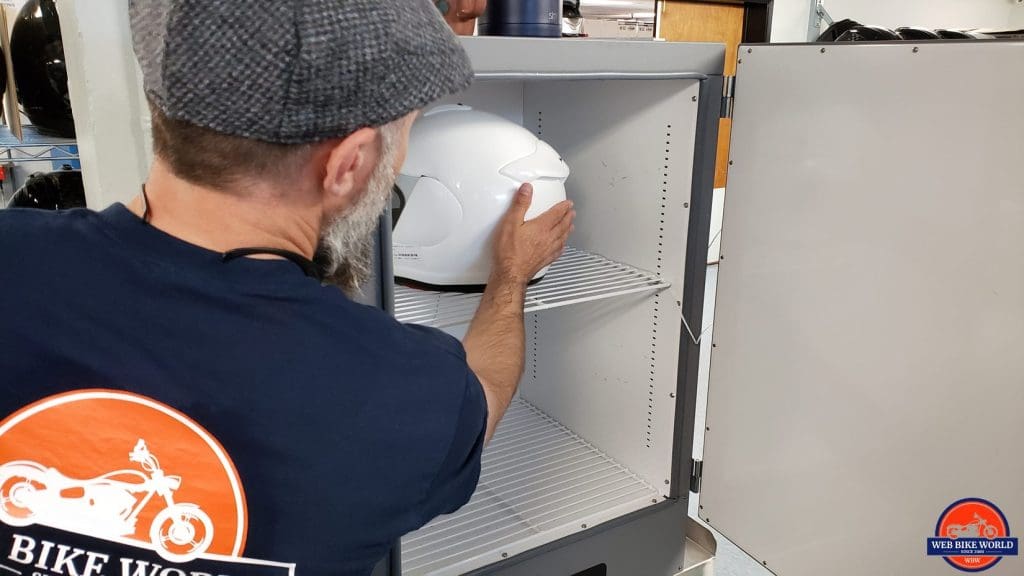
Wet. The sample shall be conditioned by being continuously sprayed with water at a temperature of 25 ±5º C (77 F) for a period of not less than four (4) hours, or more than twenty-four (24) hours. This spray shall be directed at the helmet’s external surfaces. The helmet shall not be subjected to total immersion.”
All testing of these hot, cold and wet helmets shall begin within two (2) minutes from the time of removal from the conditioning apparatus. The samples shall be returned to the conditioning apparatus between tests.”
The temperature of helmet material definitely affects how much energy is transferred through to the wearer in a crash. The Snell reps informed me EPS foam isn’t radically affected by temperature changes as some other materials used in helmets are. Plastics and some metals used in the shells and visors can become brittle when cold and maybe even melt when hot.
That’s why Snell accounts for this in their testing. Let’s face it we ride in a wide range of temperatures from one day to the next out there on the roads.
G-Forces & Headforms
The force measured after an impact test is picked up by a sensor inside a fake head that has a specific weight. They change the weight of the headform to better suit the size of the helmet being tested.
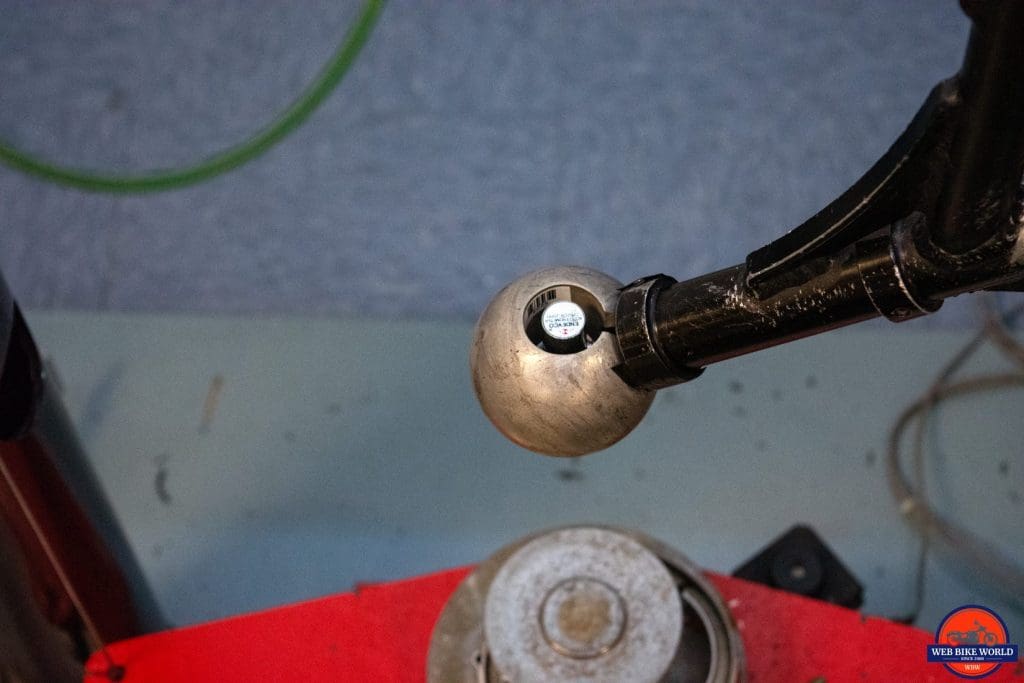
I mention the differing weight and size of these “headforms” because Snell came under serious fire in an article called Blowing the Lid off Snell from a Motorcyclist magazine writer named Dexter Ford back in 2009.
In that piece, he correctly pointed out Snell wasn’t using differently weighted headforms during the M2000 and M2005 testing process. It seems clear that a small woman or man wearing an XXS helmet will have a significantly lighter head than a gargantuan football player wearing an XXXL lid, right?
Snell fired back with this well-written response but also chose to vary headform testing weights in the M2010 standard and up. The photo above shows the collection of different sized headforms used in testing now with different weights installed inside them. I think they made the right choice with this update.
Other Testing Standards
D.O.T
Other testing labs allow for higher force transfer as in the case of DOT (Department Of Transport) standards where 400 Gs maximum is permissible. Having said that there are some asterisks involved with their tolerance levels where at times they won’t approve a helmet that registers a 250 G impact.
Yeah, it’s all a bit complicated, but rest assured DOT helmets are still good protection according to Ed Becker. They’re just not nearly as good as Snell rated ones according to the data shown to me, although even that is disputed amongst industry analysts.
Snell claims their helmets to be 40 to 80% more effective than DOT at absorbing energy in a crash.
ECE 22.05
The Economic Commission for Europe or ECE 22.05 is the main European testing standard. They tolerate up to 360 G felt in flat anvil only impacts and at only very specific points on the helmets.
Ed feels that’s a major flaw with the ECE system. Snell has tested ECE approved helmets with impacts outside those exact approved impact points and found way more energy has transferred through.
As a result, Snell hasn’t pulled any punches in publicly criticizing these ECE testing methods. They are on record saying “Snell does not recommend ECE helmets or half helmets because those helmets are inadequate for injury prevention.”
I found this surprising because I’ve always heard ECE standards were excellent. It’s even accepted in many racing organizations all over the world. ECE won’t certify a helmet without first actually testing it in their lab, much the same as SMF.
No One Really Knows
This is deep water to tread for someone like me who isn’t an engineer I admit. Many much smarter people than me have engaged in great debates over what level of G Force is safe and what isn’t for human brains to endure.
The truth is probably close to what Ed pointed out at one point in our discussion: no one really knows for sure because people are built so differently. It’s often a case by case basis, but with that in mind, it’s fair to say what we all want is the lowest possible impact force to be felt so as to protect the most sensitive subjects.
Something To Remember
In flat anvil impacts, the data Snell presents to us is that helmets built to pass their standards don’t significantly cut down the force felt through them in a crash as you can see in this chart below.
The forces felt are still slightly lower especially past 8 meters per second, so to me, there is still value there.
Now compare the difference measured when the helmet hits the curved surface of the hemispherical anvil in the chart below.
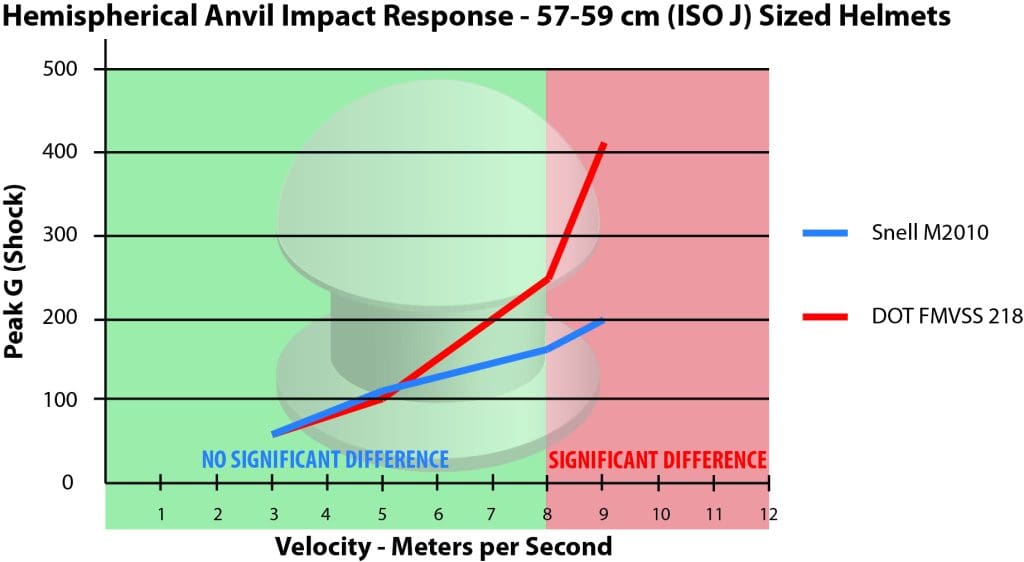
It Makes Sense To Be Prepared
It’s not difficult for me to picture my head hitting something in a crash that isn’t flat even though critics of Snell’s standards point out statistically more than 75% of the time helmets involved in crashes never encounter anything other than flat surfaces.
That does sound plausible, but what about the growing number of people who are adventure riders like myself? We spend a lot of time riding over terrain that is far from flat and often littered with rocks, logs and whatever else gets left lying around out in the wilderness.
What if it’s my head involved a “rare” case where the helmet doesn’t impact a flat surface? I’m not going to be very happy if it’s not the Snell approved helmet between my head and that rock on the ground rushing towards my cranium.
Penetration Testing
Impact testing involves a 3 kg pointed striker falling from about 12 feet onto the top of the helmet.
There’s a copper plate sitting inside the helmet that will dent even if the striker only momentarily punches through the shell to where the headform sits.
[KGVID]https://www.webbikeworld.com/wp-content/uploads/2019/09/snell-memorial-foundation-video-10.mp4[/KGVID]You can see a dimple in said copper plate in the photo above and a white dot where the tip of the striker punched through the shell and EPS foam in the photo below.
Other Snell Helmet Tests
I don’t want to go on and on about the different testing Snell does because this trip produced much more information than that, but I will quickly summarize some of the most impressive other testing they do. A fully detailed account can be found on their website here: Snell testing standards.
I witnessed all stages of the process and can vouch for the methods used being vigorous and even quite extreme in some ways. Critics argue the standards are beyond reasonable and should be relaxed or adjusted. They feel Snell is stubbornly clinging to an unrealistic ideology that isn’t practical and some even say the helmets are built too hard and can lead to injury where softer ones wouldn’t.
My Two Cents
I agree these high standards are perhaps flirting with being unreasonable, but I don’t think they should be relaxed. It’s not like Snell is failing every helmet they test. Not remotely.
Ed said that the standards haven’t been made significantly tougher to pass since M2010. In fact, they’re just about to unveil an M2020 standard that will mesh better with both DOT and ECE helmet standards, but other than that it’s still more or less the same as M2010.
As a motorcyclist and person who has a head I wish to keep in good condition, I genuinely want to know where the limit is of helmet toughness and this seems the place to work it out.
Visor Penetration Testing
I’ve been riding for over 30 years on road and off road. Over that time I’ve taken some BRUTAL hits to my helmet visors and my face at times when the visor was slightly open. Those really hurt! It begs the question of how thick does Snell believe a visor need be?
How about thick and strong enough to stop a pellet fired out of an air gun at 500 fps from only three feet away? That should do it I think. I had heard about Snell shooting pellet guns at helmets, but didn’t think they actually did it.
This was a fun test to try for myself as you can see in the photo above.
Chin Bar Testing
The chin bar strength is tested by dropping 5 kg weights on them and measuring the amount of flex in it.
Roll Off or Retention Testing
A helmet isn’t very useful if it doesn’t stay on your head when submitted to shock and prying forces, right? Snell aims to ensure the helmet can’t pop off forwards or backward if it catches on something in a crash. This one looks pretty brutal as well. Can you imagine wearing a helmet with that kind of force working to peel it off your dome?
First, it’s loaded with 1.1 kg on it and then shock loaded with 4 kg more after having fallen 60 cm.
[KGVID]https://www.webbikeworld.com/wp-content/uploads/2019/09/snell-memorial-foundation-video-02.mp4[/KGVID]Chin Strap Testing
The strength of chin straps and how well they hold together is tested by slamming a weight down while attached to a fastened strap as you see in the photo above. Incidentally, They told us that some micrometric (ratcheting style) closures do fly apart or slip a tooth when they test them this way, but not many. I’m sure Cam was just a little pleased to hear that.
Watch this video to see a chinstrap actually break on the dummy helmet during testing.
[KGVID]https://www.webbikeworld.com/wp-content/uploads/2019/09/snell-memorial-foundation-video-01.mp4[/KGVID]Fire Resistance Testing
Okay, so this last one is only performed on automobile racing helmets, but I just had to share it with you because the cool factor is off the charts. They’re setting helmets on fire. Enough said.
Take a 371 degrees Celsius (700 degrees F) flame and hold it to the helmet visor and shell for a time to see if it’ll burn through. The resultant fire on the helmet has to go out on its own after the torch is pulled away as well. Wild stuff!
Here’s The Really Interesting Part!
If you had 6 hours to quiz the helmet experts at the SMF on any helmet-related topic, what would you ask them? Believe me, I put their feet to the fire and got some very interesting answers.
These aren’t direct quotes, but more of a summary of the responses gathered from the Snell team referred to as Ed Becker or Team Snell.
Which Helmet Is The Best?
Jim: What helmet do you yourself wear when you’re riding motorcycles?
Ed Becker: Actually only one of the 9 employees here at SMF rides motorcycles and it’s not me. Two more of us have driver’s license motorcycle endorsements but again, neither one of them is me.
Jim: Ok then, which helmet would you recommend I choose to wear out of all of them on the market as the best choice?
Ed Becker: I would recommend looking at any Snell approved helmet first of course, but if you can’t find one that fits you correctly and comfortably there’s nothing wrong with a good DOT approved helmet.
Jim: So you don’t necessarily insist on people wearing ONLY Snell certified helmets?
Ed Becker: No I’m sure a good DOT helmet might still save your friends and family a lot of grief if you’re involved in a crash.
Bluetooth Devices In Helmets
Jim: Does installing a Bluetooth device in your helmet compromise it in a crash and will it potentially cause more substantial injury?
Ed Becker: Potentially yes it could cause injury if the EPS foam liner has to be made thinner to accommodate the device. An externally mounted device could also snag on the ground in a slide and injure the rider’s neck. We favor factory installed gear over aftermarket modifications. Buy the helmet you want at the start rather than make it into what you wanted later. But if an aftermarket modification is necessary, make sure it’s competently done, smoothly faired and won’t interfere with the helmet’s protective function
Helmet Drops
Jim: If I drop my helmet do I need to replace it without question?
Team Snell: Not if your head or some kind of weight wasn’t inside it when it fell on the ground. If there’s damage to the shell-like a crack or hole then yes it should be replaced, but if none of the EPS foam inside was affected (crushed) or the outer shell damaged it should still be useable.
Helmet Longevity
Jim: Helmet manufacturers recommend replacing your helmet every 3 to 5 years because they degrade over time and don’t provide the same protection anymore. Is this legit or just a way to keep selling more helmets?
Have you tested helmets older than 5 years to see if they still protect just as well?
Team Snell: Dr. George Snively, Snell’s founding father, did a study of helmets donated by retiring California Highway Patrol officers. He found that some helmets as old as 12 years tested as good as new. Others, though, that looked just as good, were completely useless.
He concluded that after five years of use, he could no longer recommend that a helmet would perform its basic function, saving someone’s life. That’s the basis of our five-year replacement advice.
Of course, most helmets won’t see the kind of action a CHP helmet might get. So we won’t try to strip the Snell sticker from your helmet after five years of use. But we’d much rather see a good helmet get tossed than for anyone to trust one that’s gone bad.
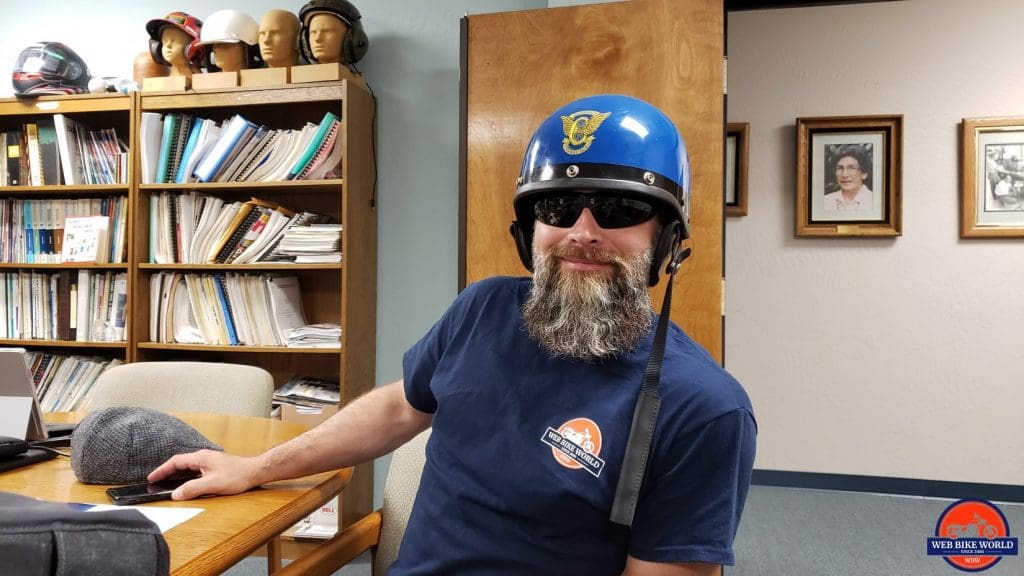


Often it’s the padding that has worn out over time resulting in the helmet not fitting snug enough anymore to provide adequate fit/protection. A loose-fitting helmet is no good to anyone.
Jim: Does the oil produced from sweaty heads inside the helmet not affect the EPS foam and break it down over that time?
Ed Becker: No not oils produced by human skin, it’s petroleum-based oils that would destroy the foam in helmets.
Gasoline is especially tough on it, by the way. We heard from a rider who attempted to use his helmet as a gas can and watched in horror as it ate the liner all the way down to the shell.
Multi-Density Foam
Jim: Companies like Shoei and Arai use multi-density foam in their helmets saying it’s a good thing. Can you explain why you wouldn’t just want high-density foam uniformly throughout a helmet?
Ed Becker: It has to do with the helmet shells. Helmet shells are much more flexible near their edges so better helmets have a denser liner there to compensate. That way the helmet can manage a severe impact near the edge where a lot of crash impacts seem to happen. Away from the edge, good helmets have much softer foams because the shell is going to be much stiffer and work a lot more of that softer liner. A dense foam in that area might transmit too much shock to a rider’s head.
The Future
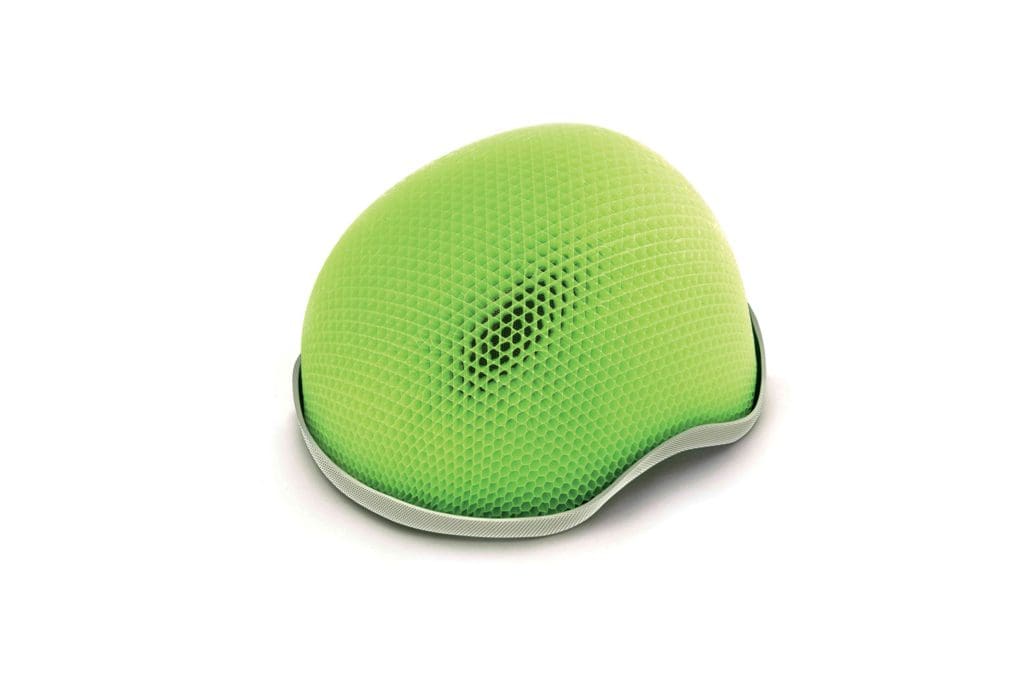


Jim: What do you think of new helmet impact absorption materials like Koroyd, for example? Have you tested any helmets with that material instead of EPS foam? They’re claiming significantly better energy absorption in impact testing than EPS foam on their website.
Team Snell: We haven’t tested a helmet with Koroyd in it and aren’t familiar with it. We’d definitely be interested in changing that. When it comes to new energy managing materials like Koroyd the main question would be how the hot/cold testing would affect it while going through our barrage of tests.
**I contacted Koroyd directly and asked about the effect temperature changes have on their product. It turns out Koroyd performs better (according to their testing) than EPS does in the -20 to +50 Celsius range. Koroyd’s post on EPS temperature tests.**
Final Thoughts on the Snell Tour
Cam and I left Sacramento that evening with intimate, first-hand knowledge, and appreciation for Snell certified helmets. We think a lot about helmets in general and have worn and tested more than a few, but the people we had just spent time with left us in awe and plenty of new data to digest.
More Please
For me specifically, this experience has produced a desire to visit more facilities like it.
The NHTSA approved labs where DOT testing is done under contract are in my sights along with the ECE 22.05, FIM, perhaps SHARP and Koroyd as well. I’ve got some work to do first in order to make it happen, but hopefully, you’ll be reading something from me about those facilities in the future.
This is important to do because I’ve only heard one side of this story from the SMF and now I need to objectively listen to the others as to why there’s so much disagreement about what a good helmet testing standard entails.
SMF and ECE, in particular, seem to be at odds with each other lately. Is it just posturing and chest-thumping? Maybe a little bit. Snell likely feels like after setting the standard for over 60 years they’re the authority and “youngsters” like ECE who only have been certifying helmets since 1982 need to “slow their roll”.
ECE favors “softer” helmets while Snell prefers “harder” ones. It seems like vastly different ideologies, but to me sounds a lot like an argument over the best way to skin a cat, quite frankly.
Which standard is endorsing the safest helmets to wear? It’s probably still Snell, but I don’t know if there’s a perfect answer, to be honest. All genuinely certified helmets seem to do a decent job of protecting the wearer’s head so long as they fit correctly and aren’t damaged before being involved in a crash. The differences between them only seem noticeable when certain specific conditions are encountered from what I can tell.
Impact tests on hemispherical anvils are a good example of this.
I still wonder why all these other testing standards cropping up now if Snell is still the top dog? Why are these other testing organizations feeling the need to test to different standards?
My Personal Experience
My own small world of experience provides an interesting perspective to consider. Five people in my social circle have been involved in life-threatening crashes on motorcycles where their head hit something with enough force to destroy their helmet.
Three out of those five escaped without head injury while one of them sustained a horrible head injury and was left in a coma for a time. One other sustained a concussion. All of them praise their helmets as having saved their life.
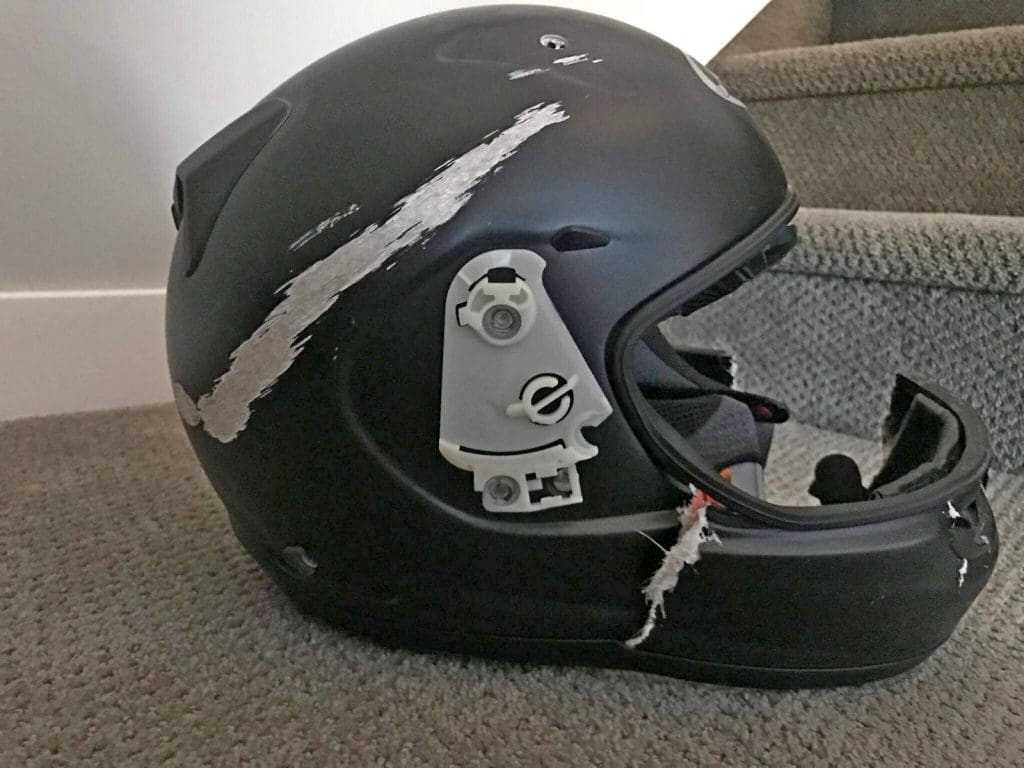


Three out of five were wearing Arai helmets, one was wearing a Shoei, the last a Bell. Four of five lids were Snell certified, but not to the same year or version of the standard because they all took place many years apart.
My friend wearing the Shoei was the one who ended up in a coma. It’s a miracle he didn’t die right away from a spinal or life-altering brain injury. The helmet literally split in half after he slammed head-first into a concrete barrier doing about 25mph. This was such an extreme case, it’s hard to even include it here.
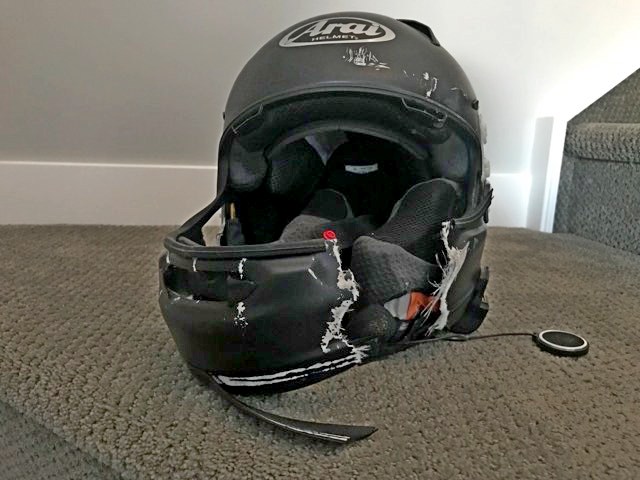


The other friend who recently crashed hard wearing a DOT approved Bell Bullitt helmet. He wasn’t “seriously” injured but was knocked unconscious for about 4 minutes.
The Bell visor had a large chunk broken out of it as you can see in the photo below, which allowed something unknown to burst through and strike him near his left eye. It left him with a nice black eye, but no actual eyeball or vision injury per se.
I realize this is probably the worst-case study to base any opinion on because it’s hardly scientific and easily brushed aside by experts. Then again, there it is right in front of you to consider.
The Big Question?
Am I going to insist on ONLY wearing a Snell certified helmet from now on?
Practically speaking, I can’t because I enjoy testing helmets for wBW and it would severely limit my participation if I did. I do have two Snell M2015 helmets in my collection at the moment.
I’m in the middle of testing an Arai DT-X right now that just so happens to be Snell M2015 certified and I couldn’t be happier with the comfort and fit thus far. That more than anything else means I’ll keep wearing it, but with a new sense of appreciation gained for its protective qualities after my visit to Sacramento.
Having said that, I’m keeping an open mind until after I chew the fat with the DOT, ECE, FIM, and SHARP people. I hope they’re half as great to talk to as Ed, Hong, Stephen, and the rest of the Snell group.


